
Abandoned & Little-Known Airfields:
Texas: Eastern Austin area
© 2002, © 2023 by Paul Freeman. Revised 10/18/23.
This site covers airfields in all 50 states: Click here for the site's main menu.
____________________________________________________
Please consider a financial contribution to support the continued growth & operation of this site.
Austin Mueller Airport (revised 10/24/22) - Guenther Field (revised 1/14/17) - Lite-Flite Austin Airfield (added 3/12/16)
Luling Memorial Airfield / Carter Memorial Airport (added 2/24/22) - Tim's Airpark / Austin Executive (revised 10/18/23)
____________________________________________________
Luling Memorial Airfield / Carter Memorial Airport (T91), Luling, TX
29.728,-97.659 (Southeast of Austin, TX)

Luling Memorial Airfield, as depicted on the August 1949 San Antonio Sectional Chart.
The Luling Memorial Airfield north of the town of Luling was not yet depicted on the January 1949 San Antonio Sectional Chart.
According to its FAA Airport/Facility Directory data, Luling Memorial Airfield was activated in March 1949.
The earliest depiction which has been located of Luling Memorial Airfield was on the August 1949 San Antonio Sectional Chart.
It depicted Luling Memorial Airfield as having a 2,800' unpaved runway.
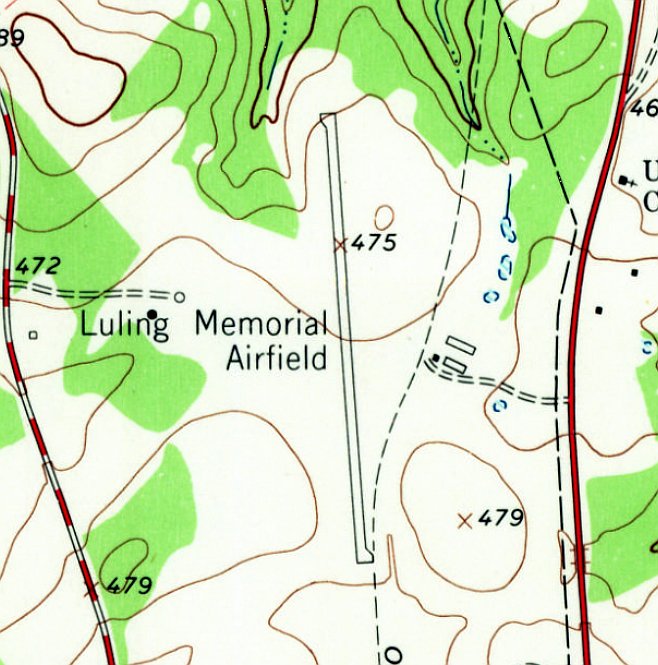
The earliest topo map depiction which has been located of Luling Memorial Airfield was on the 1964 USGS topo map.
It depicted Luling Memorial Airfield as having a single northwest/southeast paved runway, with a few small buildings on the east side.
Randy Coller reported of Carter Memorial Airport, “The City of Luling operated it but not very well. After the boom of pilots in the 1950s-70s, it started to decline.”
It was still depicted as Luling Memorial Airfield on the 1975 USGS topo map.
Luling Memorial Airfield was apparently renamed Carter Memorial Airport at some point between 1975-85, as that is how it was depicted on the 1985 USGS topo map.
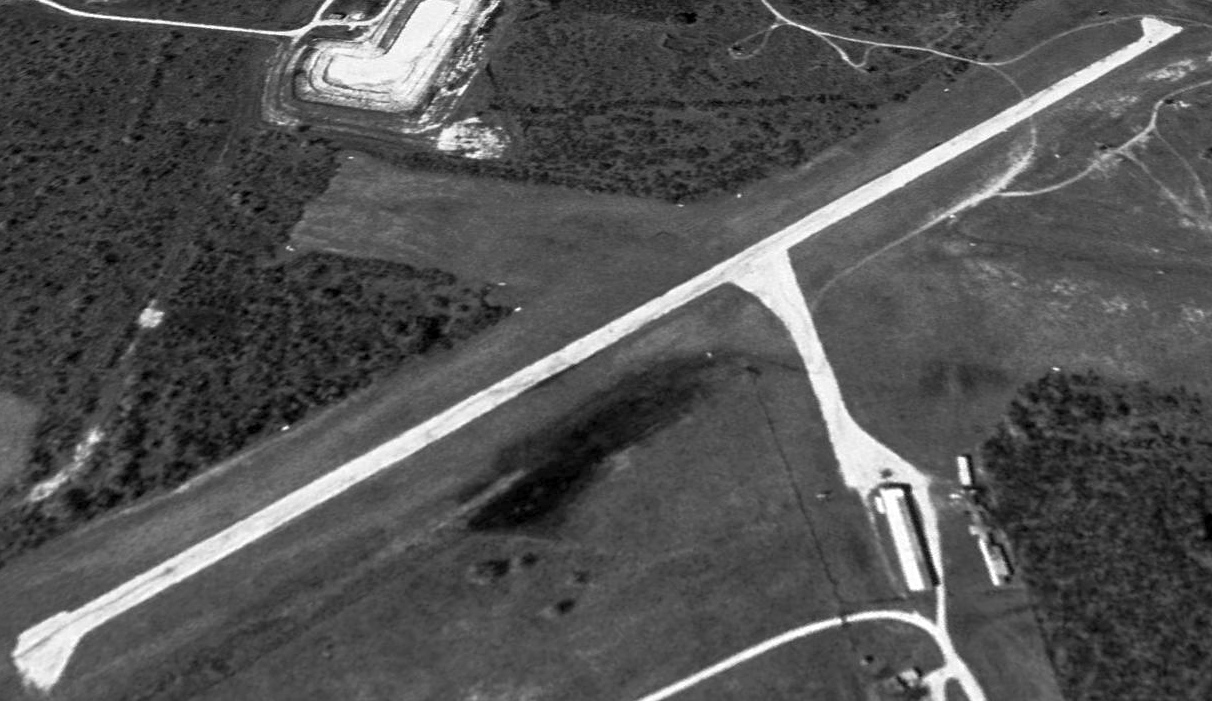
The earliest photo which has been located of Carter Memorial Airport was a 1995 aerial view looking west.
It depicted Carter Memorial Airport as having a single paved northwest/southeast runway, with a ramp & 2 small hangars on the east side.
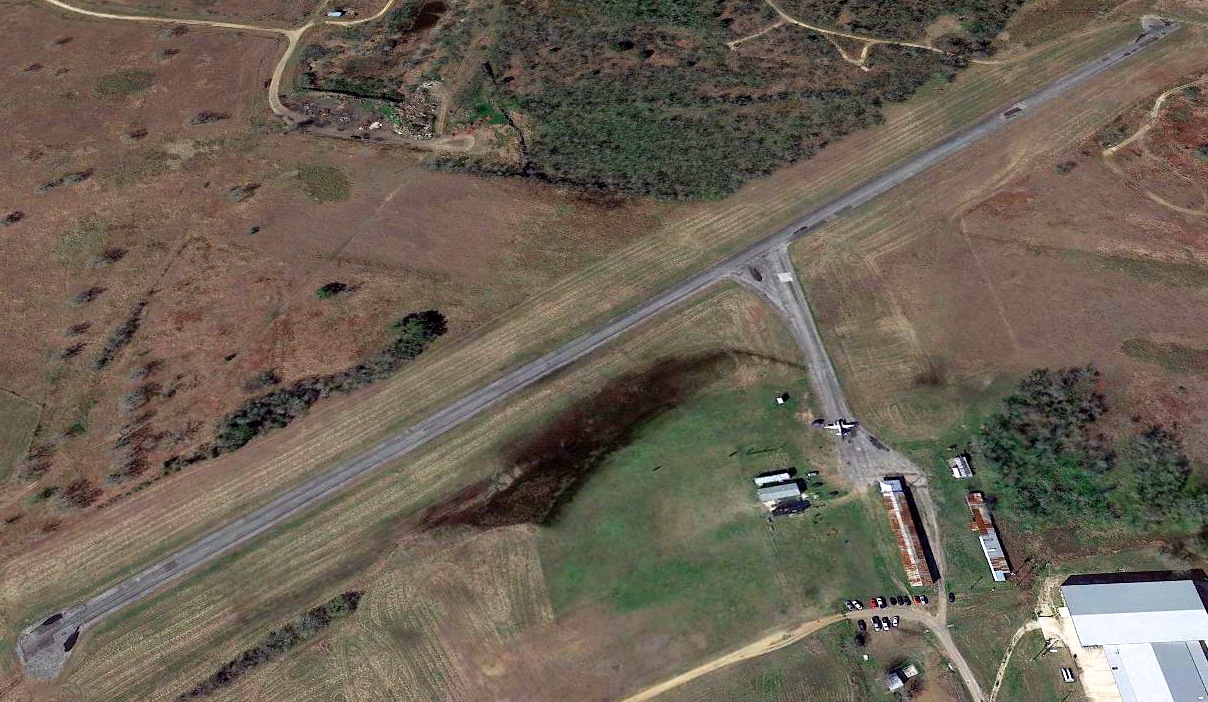
A 2018 aerial view looking west depicted Carter Memorial Airport as having a single paved northwest/southeast runway, with a Beech King Air parked on the east side ramp.
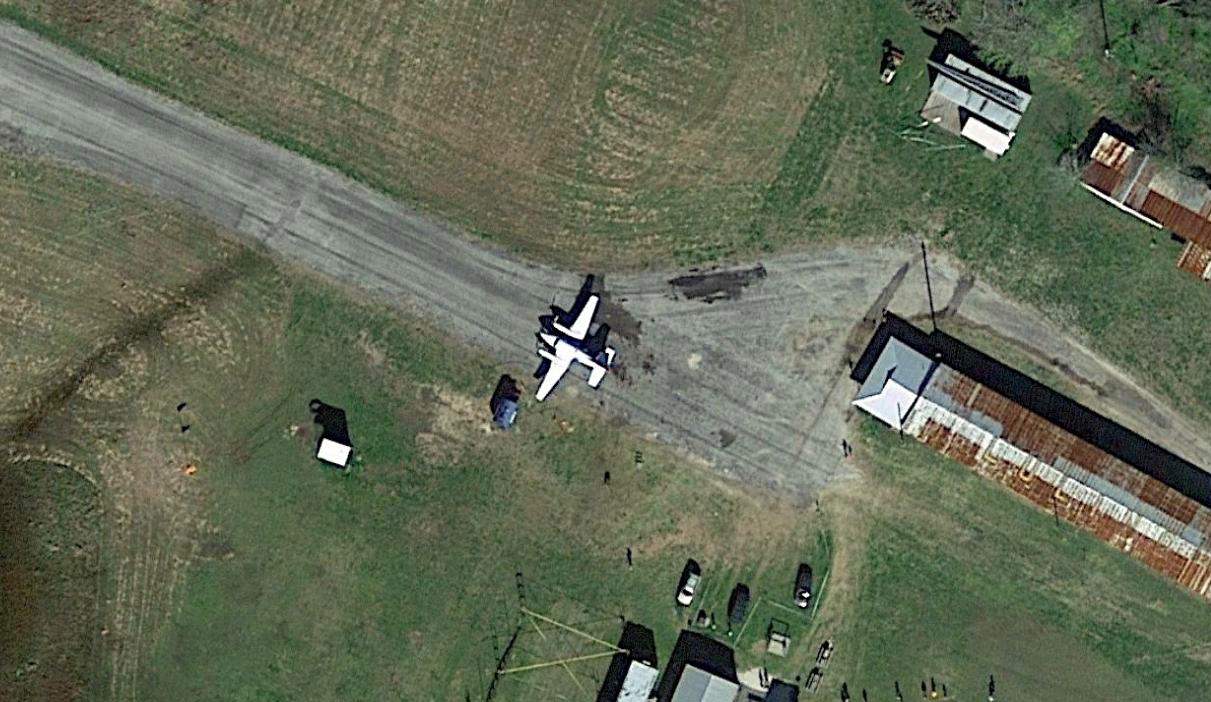
A 2018 aerial view of the Beech King Air parked on the east side of Carter Memorial Airport.
According to its FAA Airport/Facility Directory data, for the year ending 5/9/20, Carter Memorial Airport conducted an average of 23 takeoffs or landings per week.
The airport had 5 based aircraft, including 1 multi-engine & 1 ultralight aircraft.
It was owned by the City of Luling & managed by Mark Mayo.
Carter Memorial Airport was described as having a single 2,790' asphalt Runway 17/35,
but with “Extensive pavement cracking, large potholes, large pieces of aggregate, loose stones throughout.”
Randy Coller reported of Carter Memorial Airport, “In 2020 the runway was in real bad shape but there was a skydiving operation there flying a King Air.”
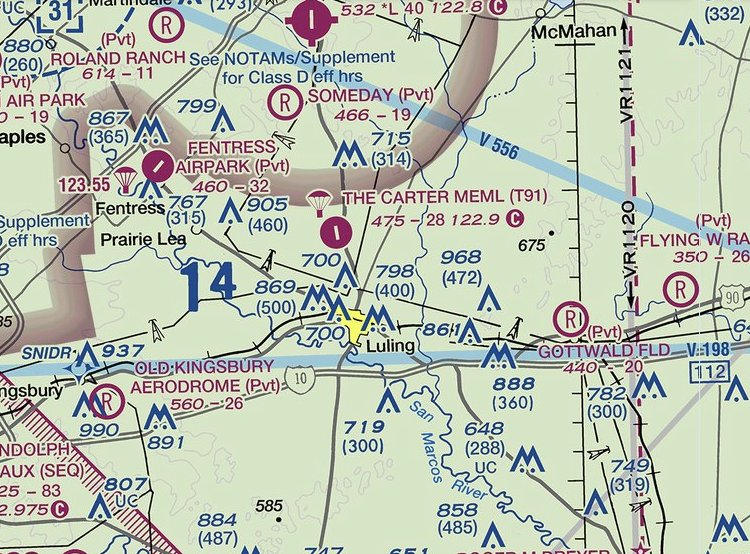
The 2022 San Antonio Sectional Chart depicted Carter Memorial Airport as having a single 2,800' paved northwest/southeast runway, and to conduct parachute operations.
Carlos Ross reported that “Carter Memorial Airport [was] closed permanently as of 2022 due to city budget cuts.
Apparently the closure occurred at the end of January, as there were still flights operated by Skydive Lone Star up to that point.”
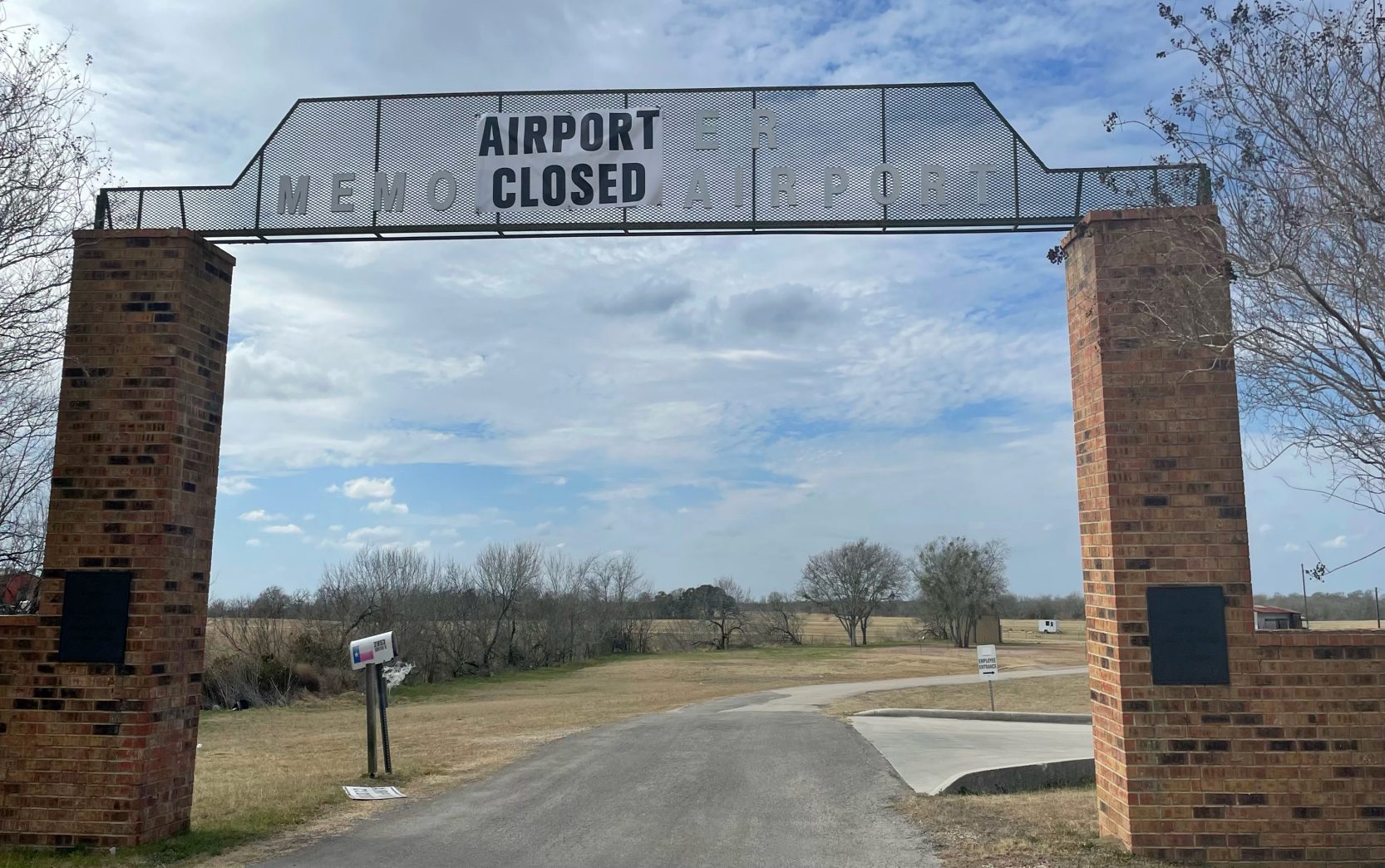
A 2/21/22 photo by Carlos Ross of the Carter Memorial Airport entrance sign, sadly superimposed with an “Airport closed” sign.

A 2/21/22 photo by Carlos Ross of the Carter Memorial Airport hangars.
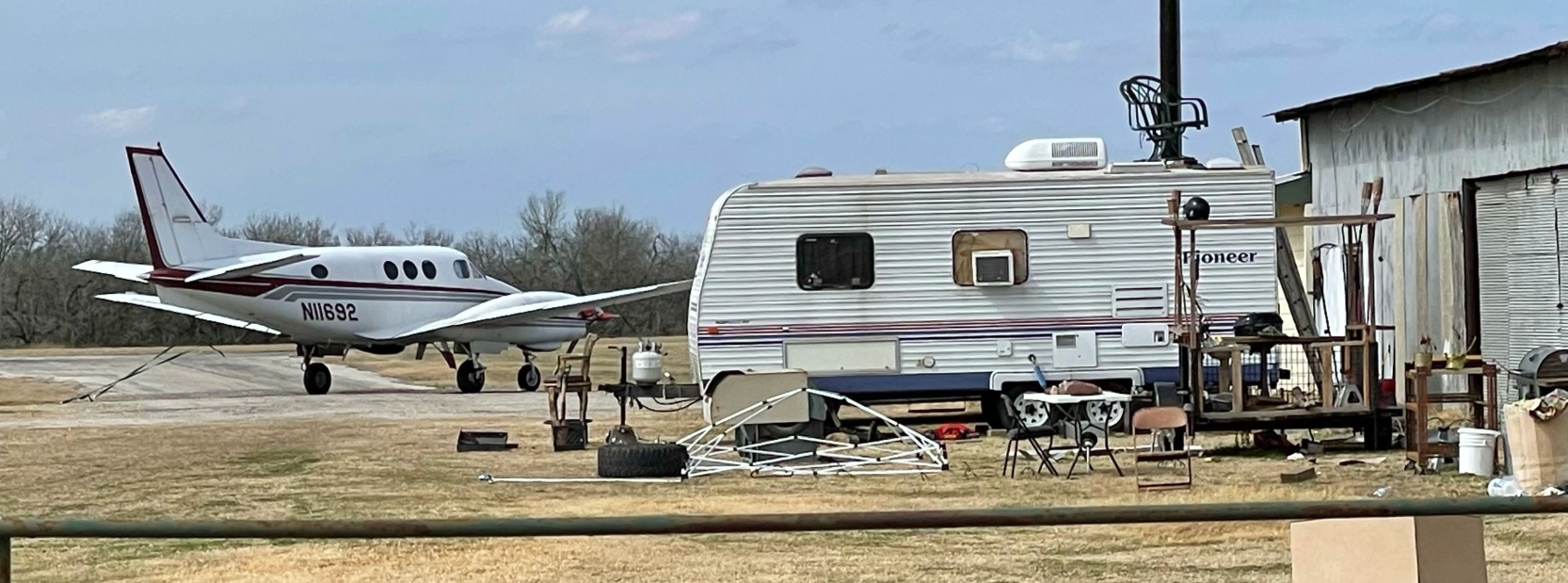
A 2/21/22 photo by Carlos Ross of the last plane at Carter Memorial Airport, the Skydive Lone Star Beech King Air.

A 2/21/22 photo by Carlos Ross of Carter Memorial Airport's Skydive Lone Star facility.
A 2023 photo showed a sign for X-Bow Systems using some of the former airport property.
The company manufactures solid rocket motors, so the facility might have an aviation purpose of a sort going forward.
Randy Coller reported in 2023, “There are some new buildings going up on the runway.”
Thanks to Carlos Ross for pointing out this airfield.
____________________________________________________
Austin Robert Mueller Airport (AUS), Austin, TX
30.3, -97.7 (Northeast of Downtown Austin, TX)
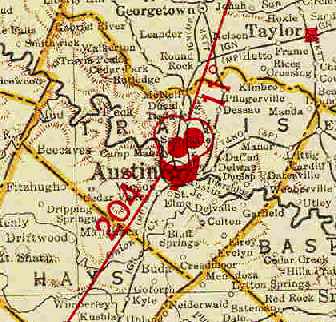
“Austin Airport”, as depicted on The 1929 Rand McNally Air Trails Map (courtesy of Chris Kennedy)
In 1928 voters approved bonds to build Austin's first municipal airport.
The City Council purchased 340 acres for $60,785
on a site outside of the city selected by Army Lt. Claire Chennault (later commander of WW2's famed Flying Tigers).
The earliest depiction which has been located of Austin Mueller Airport
was on the 1929 Rand McNally Air Trails Map (courtesy of Chris Kennedy).
It described “Austin Airport” as being located 3.75 miles northeast of the city center, and being 340 acres in size.
It was a municipal field, operated by the city.
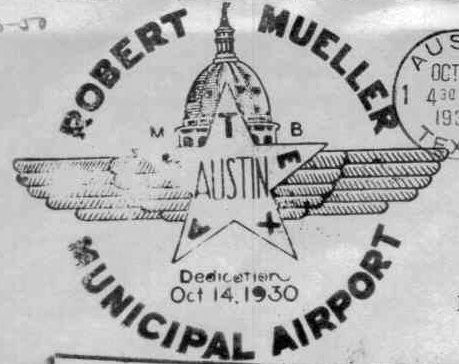
A postmark commemorated the 10/14/30 Dedication of Robert Mueller Municipal Airport.
Robert Mueller Municipal Airport opened on 10/14/30,
named for a prominent citizen & city commissioner who died in office in 1926.
The new airport featured a single runway, small office/terminal building, and one bow-trussed hangar.
Braniff International began Austin's first scheduled commercial air service on 1/1/36.
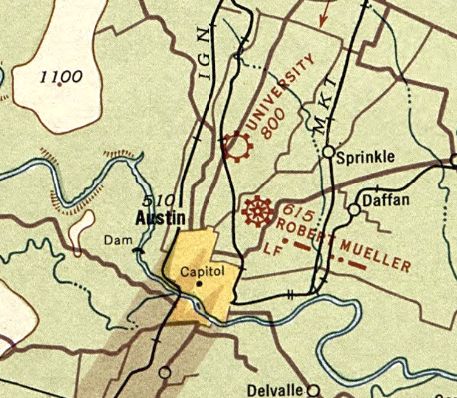
The earliest aeronautical chart depiction which has been located of Robert Mueller Airport was on the 1934 Austin Sectional Chart.

An aerial view of Austin Mueller Airport,
from the Airport Directory Company's 1938 Airport Directory (courtesy of Chris Kennedy).
The directory described Austin Mueller Airport as consisting of a 2,600' sod square landing area,
within which was a single 1,800' gravel runway.
The aerial photo in the directory depicted a single hangar on the field.

An 8/27/40 aerial view of Austin Mueller Airport (courtesy of Rob Schmidt)
showed that a 2nd longer paved runway had been added at some point between 1938-40.
A single hangar was located on the north side of the field.
A new terminal building opened at Mueller in 1942.
During WW2, Austin Mueller served as one of 4 auxiliary airfields used by nearby Bergstrom AAF.

Austin Mueller Airport, as depicted on the July 1943 Austin Sectional Chart (courtesy of Richard Doehring).

A circa 1950s aerial view of Austin Mueller Airport (courtesy of Rob Schmidt)
showed a dramatic expansion of the airfield facilities compared to the 1940 photo,
with 2 much longer runways having been added on the west side of the field,
along with 3 rows of hangars on the northeast side, along with another hangar on the southwest side.
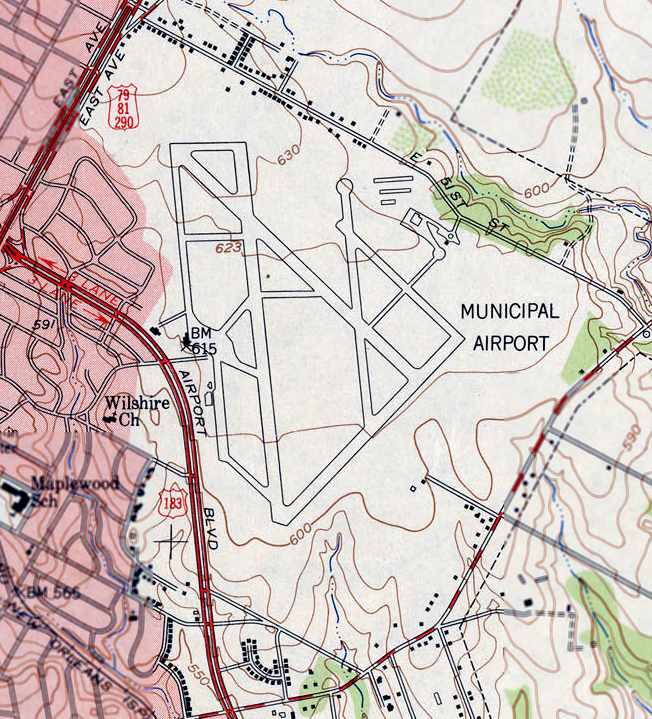
The 1954 USGS topo map depicted Austin “Municipal Airport” as having 5 paved runways, and numerous taxiways & hangars.
It also depicted the original terminal, on the west side of the field.
In 1956 the city extended Mueller's runway to 7,629' to accommodate jet traffic.
The original site was expanded to 711 acres by acquiring adjoining land, including the farm belonging to Roy Aldrich.
David Brooks recalled, "I flew hundreds of times in & out of Austin over many years (1957-91).
I did fly there as a private pilot & a passenger (mainly) on commercial aircraft.
The original 'new terminal' only had a covered walkway out to the planes
from the central building with its distinctive scalloped roof front.
It was that way up to 1968 as I have a picture of me leaving on a Braniff BAC-111 from the 'gate 1'.
The original terminal was to the side corner which was a wood building, not too much.
At that time, Austin only had about 15-25 flights per day.
When I was going to the UT, my first commercial flight was from there aboard a Braniff CV240.
During the late 1950s, Continental introduced 2 daily Viscounts - first jets into Austin.
I flew on the Viscounts from Austin to Houston on visits to relatives in Houston.
Otherwise, you had Trans Texas’s DC-3s.
Braniff flew on 'large' DC-6 per day into Austin from Dallas Love.
Braniff had about 9 flights per day Dallas to Austin (mainly) & Austin to San Antonio.
Occasionally they operated non-stop to Corpus Christi.
Trans Texas flew to Houston Hobby & Dallas Love.
Continental flew to Houston Hobby, San Angelo, and Midland/Odessa.
While President Johnson was in office during the 1960s,
Braniff flew a single daily non-stop from Austin to Washington Dulles using a Boeing 727-100."
David continued, "There was a viewing area on the terminal part of the building
with stairs you could go up & watch the comings & goings.
They had a total of 5 gates. Just a fence gate to go through to board the aircraft.
During the late 1950s to the early seventies, the principal air carriers serving Austin
were Braniff, Continental & Trans Texas (Texas International later).
That was the choices during regulation days of the FAA."
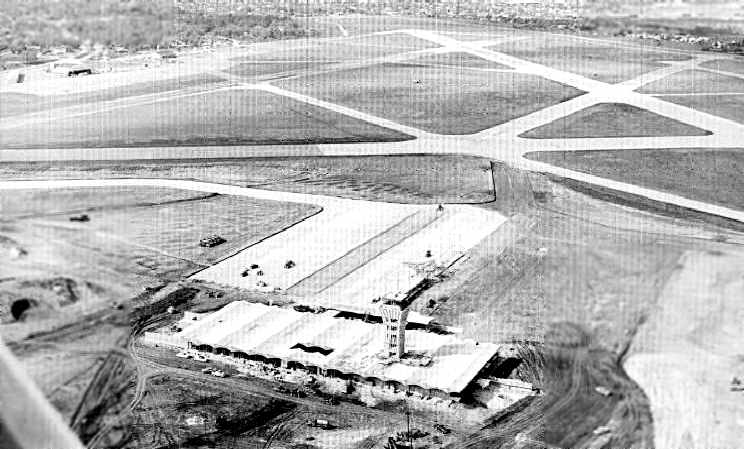
An early 1960 aerial view looking north at the new Austin Mueller terminal under construction.
The terminal building itself was complete, although work was still underway on the apron & gate pier.
Robert Mueller Airport opened its new 'jet age' passenger terminal in 1960 to replace a much older temporary building.
Although jet service from the airlines serving Austin (Braniff, Trans-Texas & Continental) was still many years off,
the terminal was hailed as a modern showplace for the fast new aircraft.
Never mind that the 707 & DC-8 aircraft couldn't operate from the short runways at the airport!
The building was single-story, with ticketing at the north end & baggage claim to the south.
A full-service restaurant, passenger lobby, newsstand & gift shop were located in between the two,
a design typical of mid-size terminals of the era.
Extending across the apron from the lobby was an open-air passenger pier with parking for 8-10 aircraft.
All boarding was at ground level.
The architecture of the building, in contrast to the layout, was definitely eye-catching.
The main terminal featured a series of waving roof trusses designed to mimic clouds.
Glass walls & landscaped planters inside created a pleasant atmosphere for departing & arriving passengers.
Perhaps the most notable feature of the building, however, was the control tower -
a graceful, curved structure paneled in blue & white, with the cab at the top.
The tower quickly became the terminal's - and one of the city's - most recognizable features.
In 1961 the new Mueller terminal & iconic control tower were dedicated in a ceremony
attended by Vice President Lyndon Johnson & Mayor Lester Palmer.
By the time of the 1963 TX Airport Directory (courtesy of Steve Cruse),
Mueller had a total of 5 paved runways (the primary runway, 12R/30L, was 7,300'),
as well as numerous taxiways, ramps, hangars, and a terminal with control tower.

The 1966 Austin Sectional Chart (courtesy of John Price) depicted Mueller as having a longest runway of 7,300'.
By the end of the 1960s, all 3 airlines had introduced jet services at the airport,
Braniff with 727s, Texas International with DC-9s, and Continental with a mix of the 2 types.
In the early 1970s, the airport underwent its first major expansion,
in the form of a second-floor boarding area over the airside pier.
A new sloping ramp was built connecting the main terminal with 6 upper-level gate holdrooms, all equipped with jetway loading bridges.
Braniff operated from the 3 gates on the south side of the pier,
while Continental & Texas International shared the 3 north-side gates.
The baggage claim area was also extended & carousels installed.
Larry Dunbar recalled, “When I first came to Austin in 1974, I had a job that took me by Muller on I-35 in the evening.
I recall Continental operating either a 707 or 720 on an evening flight into Austin at that time.
It was impressive to see a 4-holer on final at what seemed like 10' over the highway.”
Traffic really started to grow after deregulation in 1978.
Southwest Airlines began service that year, with flights to Dallas, Houston & Midland.
Following the Continental / Texas International merger & collapse of Braniff in 1982,
a slew of new airlines opened up routes to Austin -
Delta, American, United, USAir, Piedmont, America West, TWA, Ozark & Republic, among others.
A 5-gate 'rotunda' was added to the end of the passenger pier in the early 1980s to accommodate the extra airlines.
American & Delta took over this addition & remained its primary tenants until the terminal closed in 1999.

A circa 1980-85 aerial view of Mueller (courtesy of Steve Cruse).
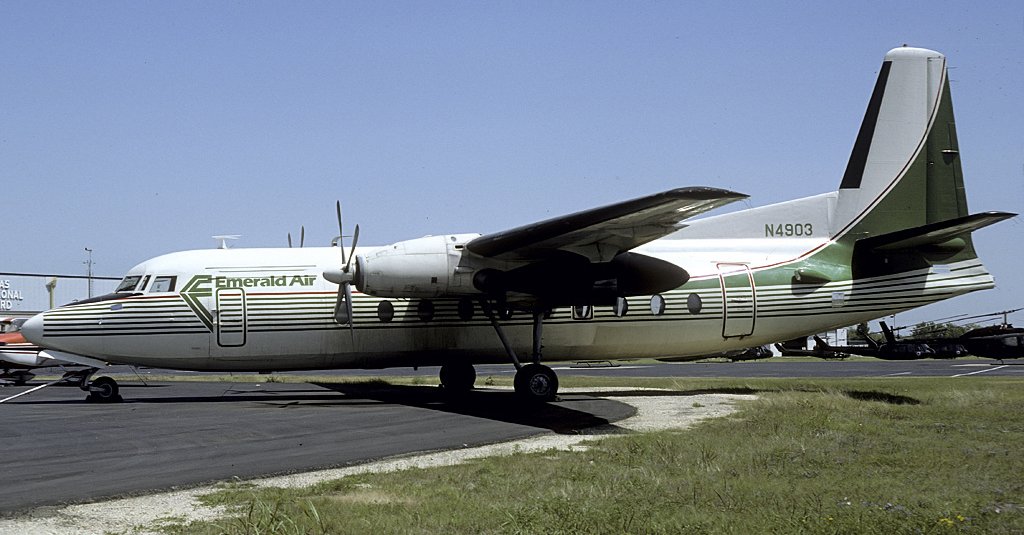
An April 1984 photo of Emerald Air Fairchild F-27B N4903 C/n 15, parked next to Mueller Airport's Army National Guard compound.
In the mid-1980s, the city of Austin abandoned plans to construct a new terminal & parallel runway
and instead began searching for a site to build a replacement airport.
In the meantime, they approved a 'stopgap' bond package to allow for improvements at Mueller.
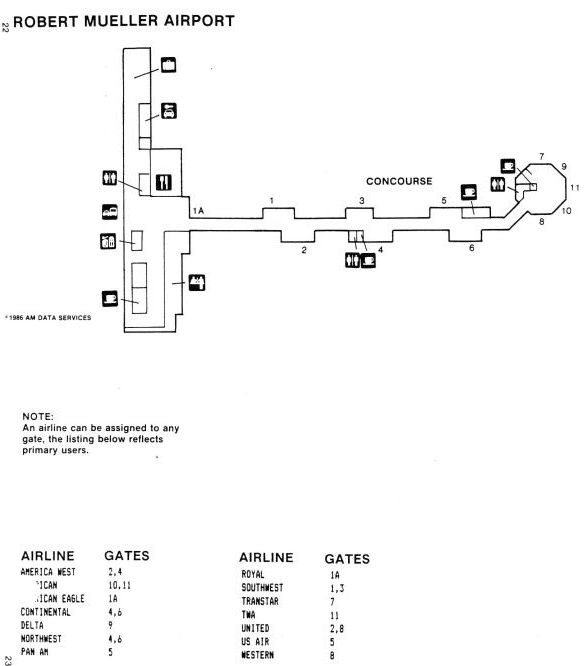
A 1987 diagram of Mueller's terminal.
Southwest, which had become the airport's largest carrier, opened its own 'unit terminal' in 1988.
Known as the East Terminal, it featured 4 jetway-equipped gates & a single large departure lounge,
constructed above new ticket counters & operations offices.
The arrival & departure roadways were also widened & redesigned.
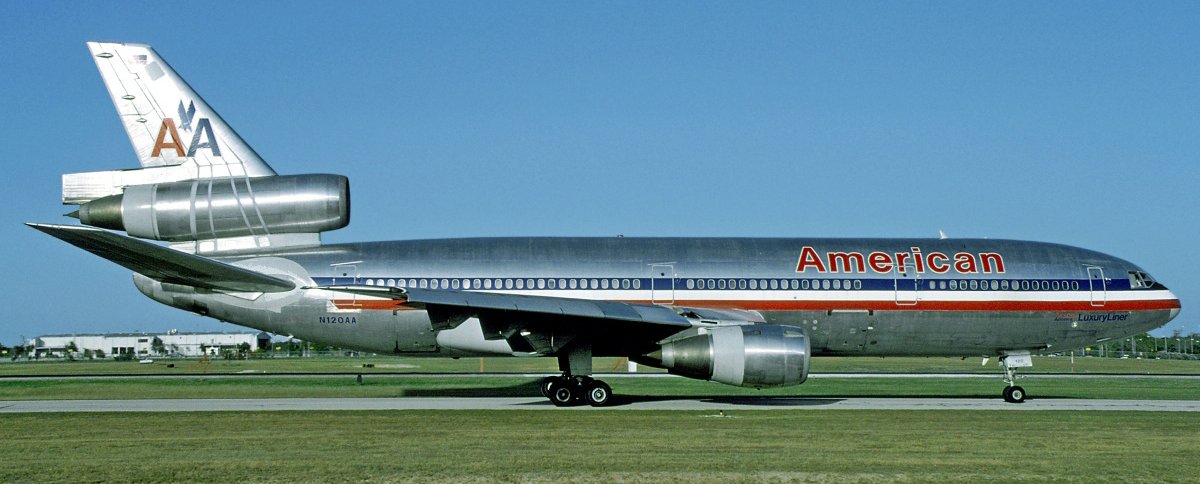
An October 1992 photo by Michael Roeser of American Airlines McDonnell Douglas DC-10-10 N120AA C/n 46520/54 at Mueller Airport.
For a time during the early 1990s, American even operated DC-10s on the Austin-DFW run,
although these were later replaced by 757s & MD-80s.
The East Terminal was bursting at the seams with Southwest flights -
Austin had some of Southwest's fastest turnarounds as a result of pressure to accommodate incoming flights.
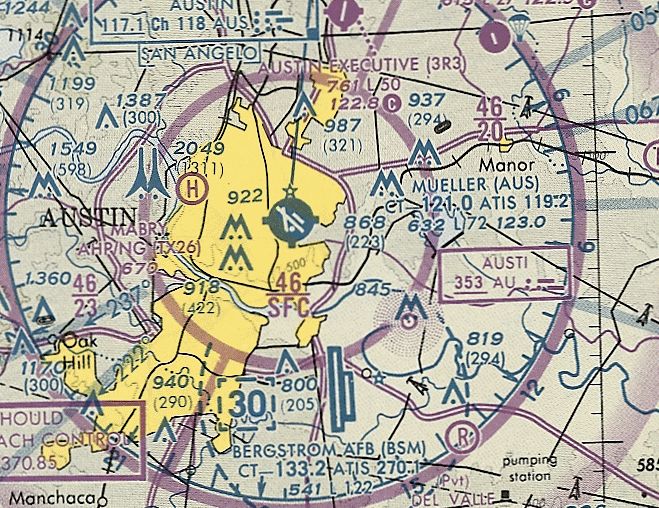
The last aeronautical chart depiction which has been located of Mueller Airport
was on the May 1993 San Antonio Sectional Chart (courtesy of Ron Plante).
It depicted Mueller as having 3 paved runways, with the longest as 7,200'.

The last aerial view which has been located showing Austin Mueller Airport while still open was a 1995 USGS aerial view looking north.
In 1997 the State of Texas, after considering plans to take over Mueller & keep it open as an airport,
announced it would instead acquire 282 acres of the Mueller site for a new office complex.
The tower at Austin Mueller, decorated for Christmas 1998, shortly before its closure.
Photo copyright Airnikon, used by permission.
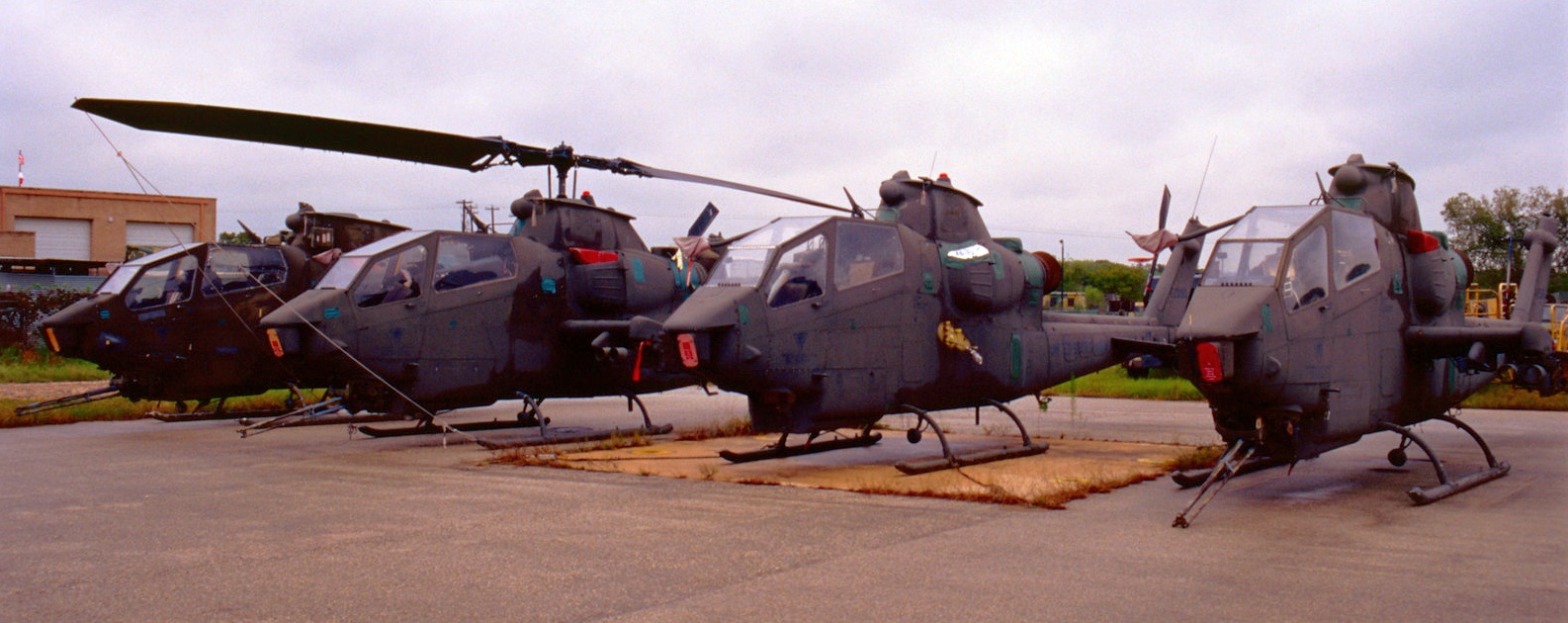
A November 1998 photo of the sad sight of derelict Army National Guard Bell AH-1F Cobra Gunships stored at the Mueller Airport National Guard property, serial #s 0-15116, 0-15460, 0-15572, 0-23190 & 0-23248.
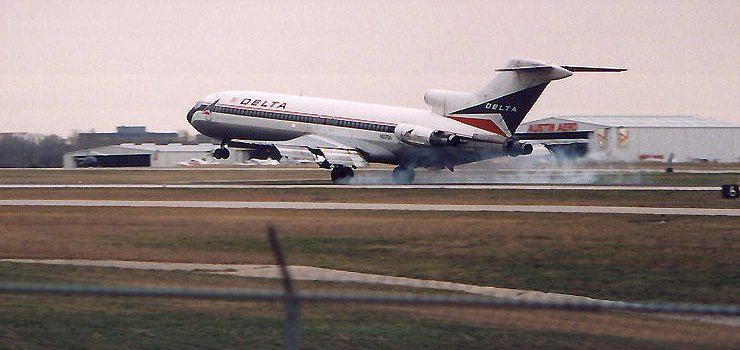
The last photo which has been located showing an aircraft at Austin Mueller Airport
was a 3/9/99 photo by Damon Alexander of Delta Airlines Boeing 727-232 N514DA MSN 21430 landing on Runway 31L.
After almost 40 years of operations, Austin-Mueller finally closed its doors in March of 1999 & all operations transferred to Bergstrom.
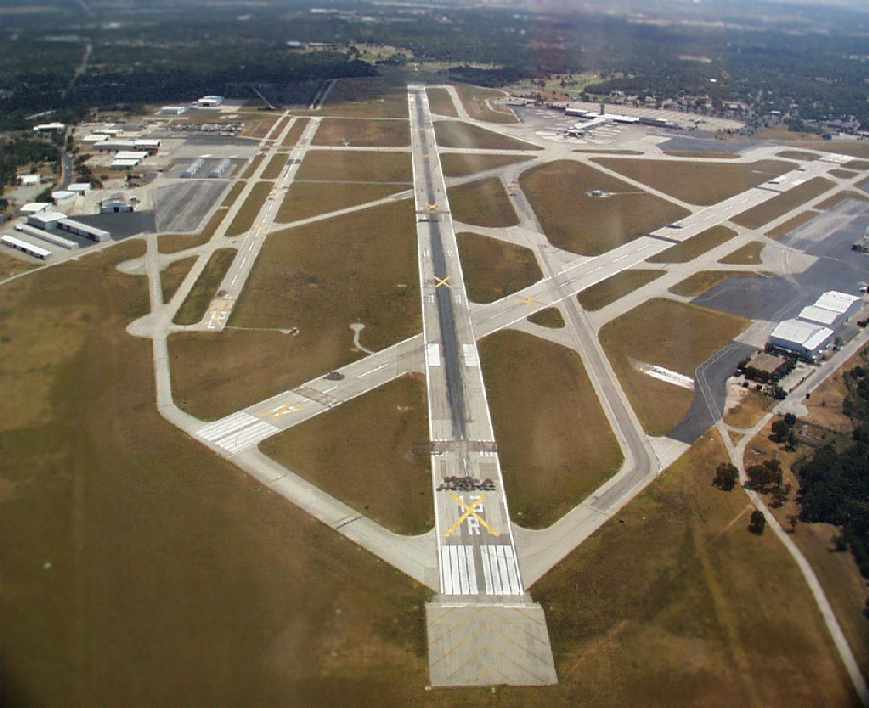
A circa 2000 aerial view by Bill Gunn looking looking southeast at Austin Mueller, taken about a year after the the field was closed.
For several years after the closure, as the city finalized redevelopment plans,
the extensive aviation infrastructure at Mueller sat completely abandoned.
The Aircraft Owner's & Pilots Association had lobbied to reopen Mueller for general aviation use, but this was an uphill battle.
The local government's redevelopment plan called for absolutely no future aviation uses, but rather for homes & businesses to cover the site.
A 2001 photo (copyright Jason Knutson, used by permission) of the abandoned control tower at Austin Mueller.
A 2001 photo (copyright Jason Knutson, used by permission) of the abandoned Delta & American Airlines jetways at Austin Mueller.
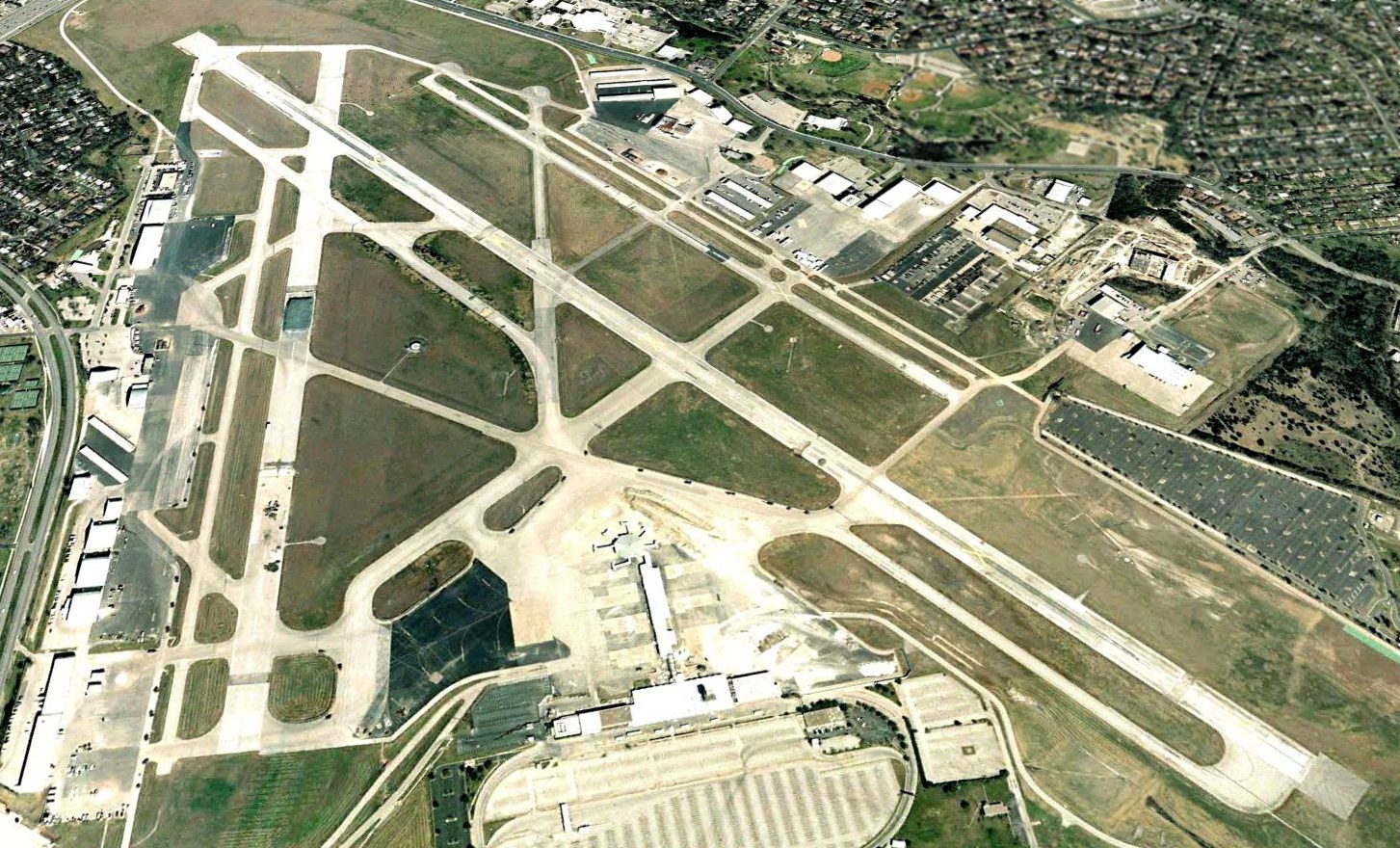
The last aerial view which has been located showing Austin Mueller Airport before demolition began was a 2001 aerial view looking north.
A tremendous amount of paid-for aviation infrastructure, all to shortly be destroyed.

Two 2002 photos of the passenger pier being demolished at Austin-Mueller - a sad day in the former airport's history.
Major demolition & redevelopment of the Mueller site finally got underway in 2002.
The main pier & rotunda came down first, although Southwest's East Terminal has supposedly been removed as well.
The control tower will remain on the site as a memorial to the airport.
By September 2002, there was no trace of the pier area,
and the touchdown marks on the runways were beginning to fade as well.
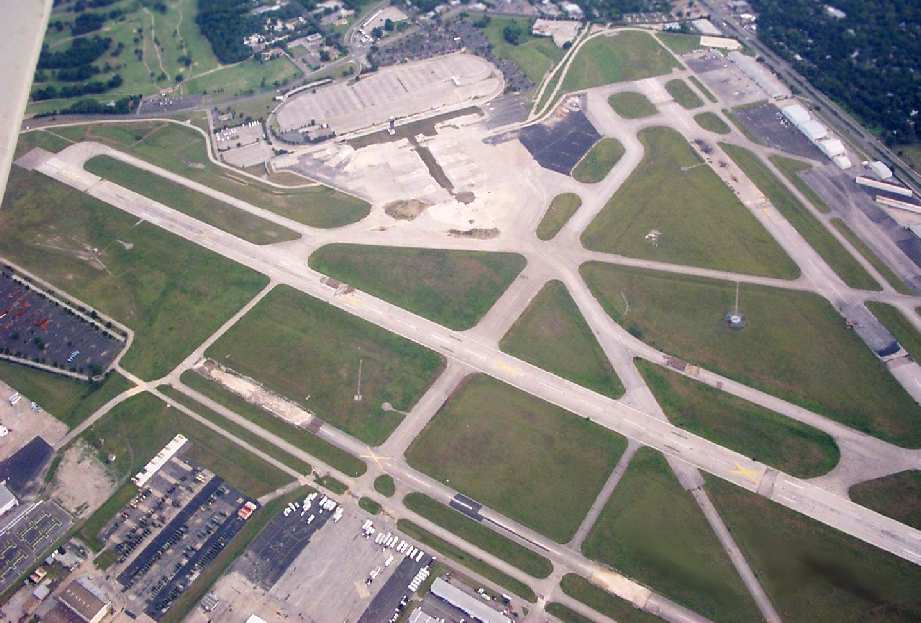
A 2003 aerial view looking south at the remains of Austin Mueller Airport, by Dick Merrill.
Notice the terminal has already been completely removed.
What an incredible waste of infrastructure paid for by the taxpayers.
A 2003 photo by Scott Murdock of the Austin Mueller control tower.
Scott observed, "The control tower stands, as do the airport access roads with overhead signs,
and the parking areas with their access gates & tollbooths.
But the terminal building itself has been demolished, making an eerie setting."
A 2003 photo by Scott Murdock of a former Austin Mueller hangar.
In an incredible case of irony (and poor municipal planning!),
as of 2003 several elected Austin leaders were lobbying for Austin Mueller to be reopened, as a general aviation reliever airport.
This would be to alleviate the lack of general aviation facilities in the Austin area, now that Austin Executive Airport had been closed,
and the "new" Austin International Airport (the former Bergstrom AFB) offered extremely limited general aviation facilities.
They couldn't have just saved a lot of tax dollars & effort by keeping it open, could they? All that aviation infrastructure, bought & paid-for, all gone to waste.
cgzapalac repored, “The last aircraft known to have landed [at Mueller Airport] was N4700V in August 2004 on Runway 35 though the attempt was about 150' short.
The aircraft did not survive the landing but the pilot walked away. At least [it] tells you that Runway 17/35 was still clear in August 2004.”
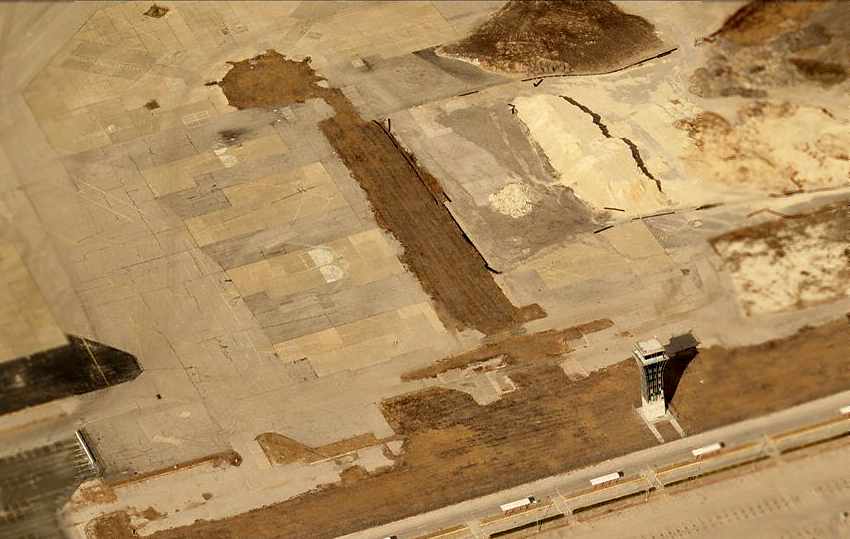
A circa 2005-2006 aerial view looking north at the odd sight of the former Austin Mueller control tower,
now standing alone, with the site of the now-demolished terminal building just behind it.

A circa 2005-2006 aerial view looking west at one of several former hangars remaining on the north side of the former field,
this one emblazoned with the TX flag on the side.
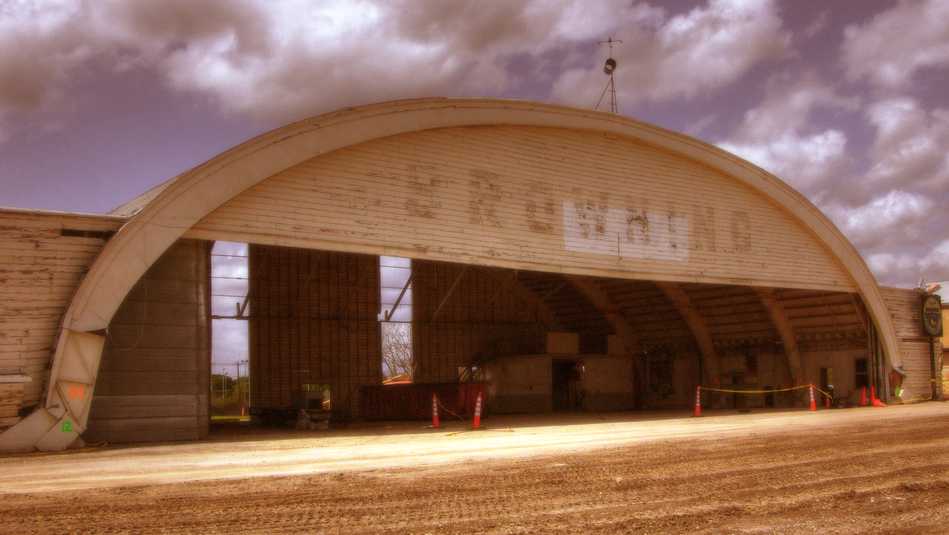
A 3/24/07 photo of a Mueller hangar, with “Browning” still visible across the top, in the process of demolition.

An 8/27/07 photo of Austin Mueller's control tower.
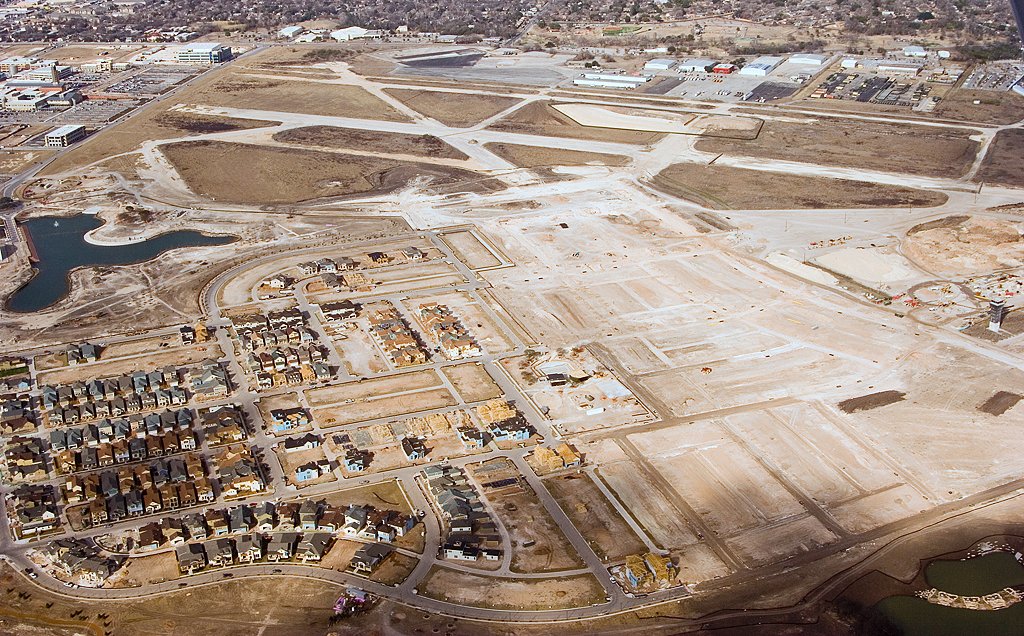
A 2/2/08 aerial view looking north at the site of Austin Mueller Airport, with the control tower still visible on the right,
houses covering the southwestern portion, but runways still visible in the background.

A 5/31/08 photo of Austin Mueller's control tower by Terry Keel.
Terry observed, “From this vantage you would be driving roughly west, the tower & now-missing terminal facility to the right,
new residential development on the old airport grounds straight ahead.”
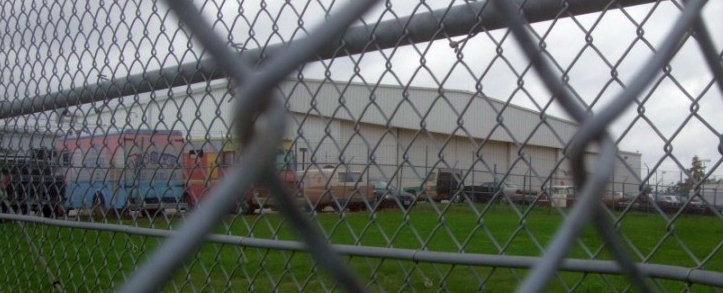
A 11/11/15 photo by Ron Plante of a former Mueller Airport hangar.
Ron reported, “This field has been heavily developed, and if there is any pavement left I could not see it from the perimeter.
On the northeast side off Old Manor Road are 2 former hangars, but they’re inside the fence line & hard to view. Other structures could still be present.”
Ron Plante visited the former Mueller Airport control tower on 11/11/15,
and reported, “On the south side, I was shocked to see the tower still standing next to rows & rows of new housing.
Similar new housing is going up on nearly the entire site.”
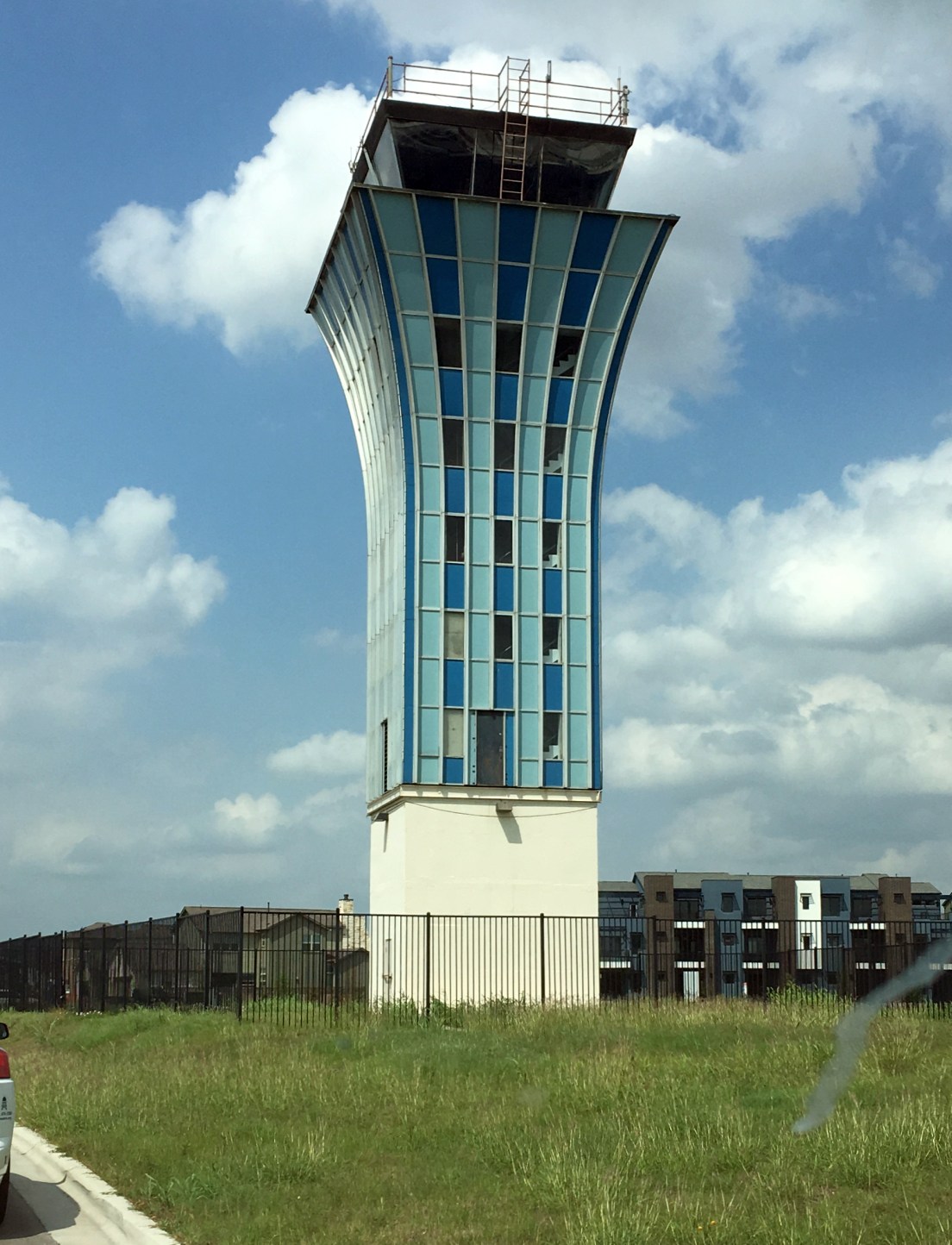
A 3/28/17 photo by Colin Zapalac of the former Mueller Airport control tower.
What a shame to see this beautiful piece of TX aviation history fenced-off & neglected.
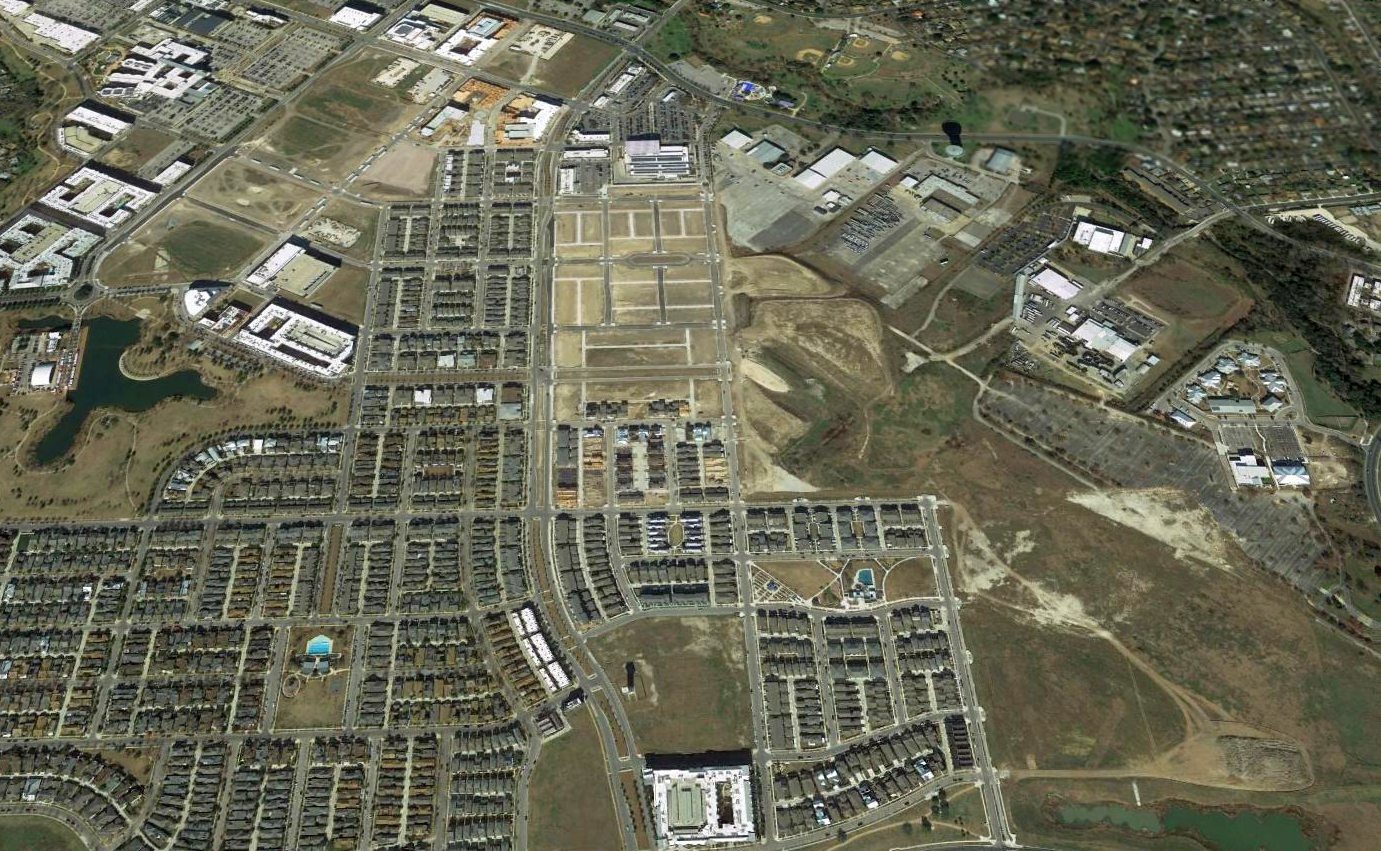
A 2017 aerial view looking north shows the site of Austin Mueller Airport to be unrecognizable as a former airport.

An 8/18/17 aerial view by Robert Torn of the former Mueller Airport control tower among all the redevelopment of the airport site.
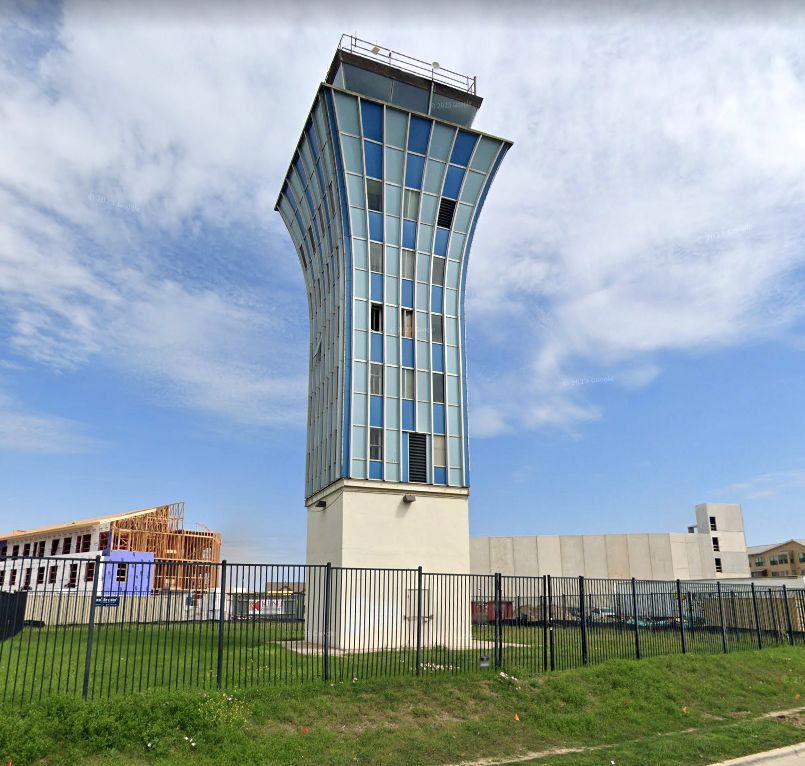
A bizarre sight: a 2023 photo looking east at the former Mueller Airport control tower, fenced-off from the surrounding redevelopment.

A 2023 3-D aerial image looking west at 2 former Mueller Airport hangars, on Old Manor Road.
They are reused by Troublemaker Studios – note the facade which has been constructed behind the hangar at top-left.
____________________________________________________
Lite-Flite Austin Airfield, Manor, TX
30.348, -97.49 (East of Austin, TX)
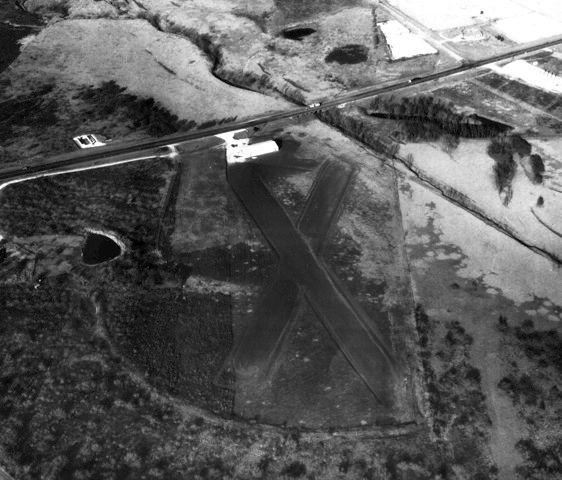
A circa 1984-85 aerial view looking north at Lite-Flight Austin Airfield, taken by the reconnaissance camera of an Air Force RF-4 Phantom (courtesy of John Melvin).
This small airfield was operated by the Lite-Flight Ultrasport ultralight aircraft company.
The date of establishment of the Lite-Flight Austin Airfield has not been determined.
It was not yet depicted on the January 1972 San Antonio Sectional Chart (courtesy of Ron Plante).
The earliest depiction which has been located of this airfield was a circa 1984-85 aerial view (courtesy of John Melvin).
John recalled, “It was taken from an RF-4 using its reconnaissance camera system by a neighbor of mine who was a pilot out of Bergstrom AFB.
He had mentioned the location in a briefing & it was requested that he get some photos as the site was near a low-level training area.”
It depicted Lite-Flight Austin Airfield as having 2 grass runways in an X-shape, with a building on the north side.
John Melvin recalled, “Lite Flite Austin... was a satellite operation of Lite Flite Katy.
I was working at Lite-Flite part-time assembling ultralights & flying as often as I could.
Some of us flew from there to Tim's Airpark & back on several occasions.”
The Lite-Flight Austin Airfield was not depicted on the 1986 San Antonio Sectional Chart (courtesy of Ron Plante),
nor was it depicted on USGS topo maps.
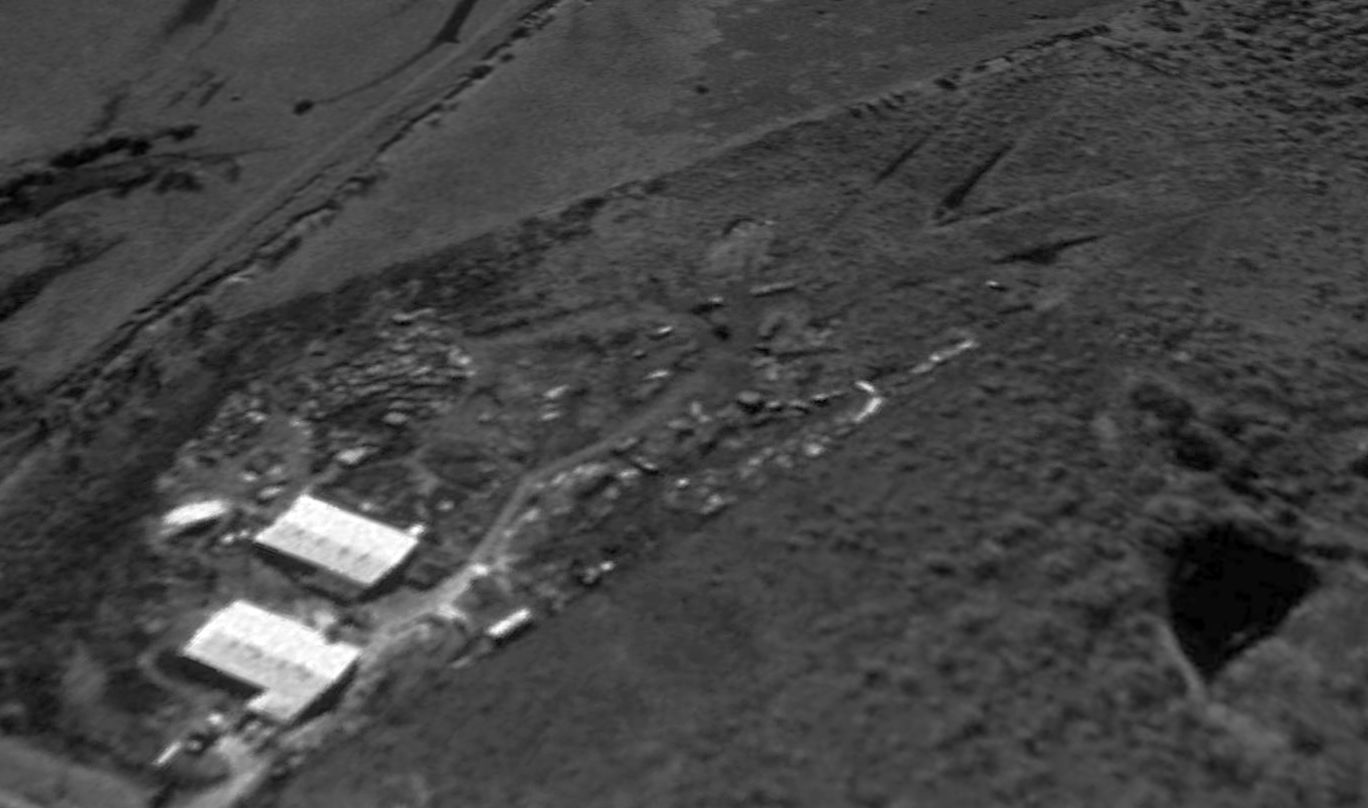
Lite-Flite Austin Airfield was evidently abandoned (for reasons unknown) at some point between 1984-95,
as a 1995 aerial view looking southeast showed the X-shape of the 2 runways was still recognizable but they were notably overgrown.
A second building had been added north of the runways at some point between 1989-95.

Lite-Flite Austin Airfield may have been reopened at some point between 1995-2011,
as a 2011 aerial view looking southeast showed what appeared to be a new unpaved runway, not reusing the previous runway alignment but instead running north/south.
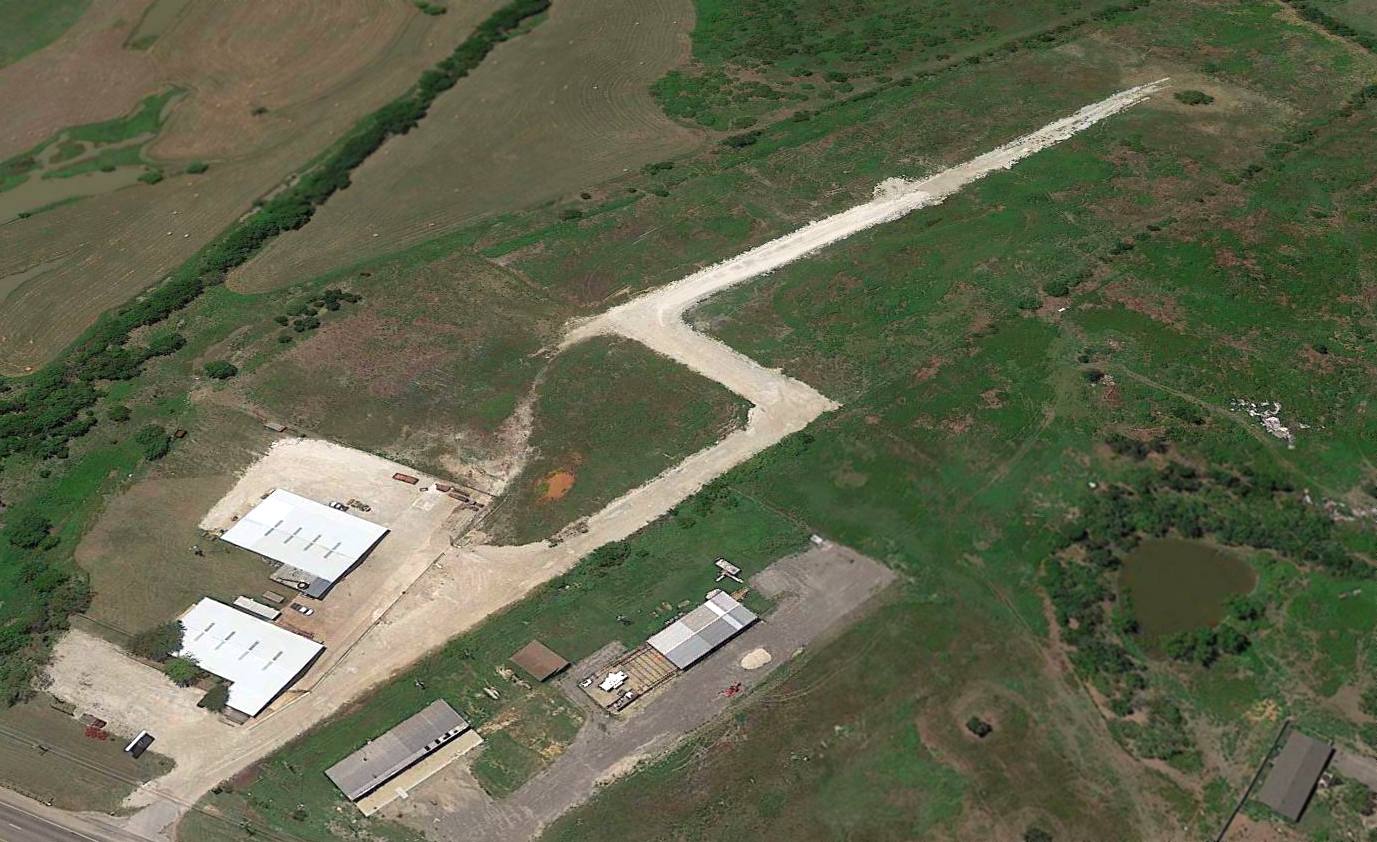
A 2015 aerial view looking southeast at the site of Lite-Flite Austin Airfield showed that the north/south runway appeared to have been partially paved at some point between 2011-2015.
The site of Lite Flite Austin Airfield is located southeast of the intersection of Route 290 & Old Kimbro Road.
Thanks to John Melvin for pointing out this airfield.
____________________________________________________
Guenther Municipal Airport / Guenther La Grange Airport, La Grange, TX
29.9, -96.9 (Southeast of Austin, TX)
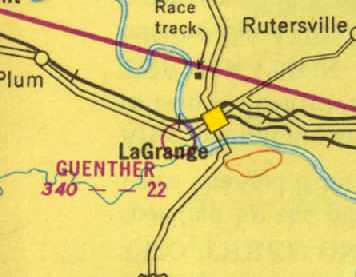
Guenther Municipal Airport, as depicted on the 1950 San Antonio Sectional Chart (courtesy of David Brooks).
The original airport for the town of La Grange was located adjacent to the southwest side of the town.
Guenther Municipal Airport was apparently established at some point between 1949-50,
as it was not yet depicted on the January 1949 San Antonio Sectional Chart (according to Chris Kennedy).
The earliest depiction of Guenther Municipal Airport which has been located
was on the 1950 San Antonio Sectional Chart (courtesy of David Brooks).
It was described as having 2 turf runways, with the longest being 2,200'.
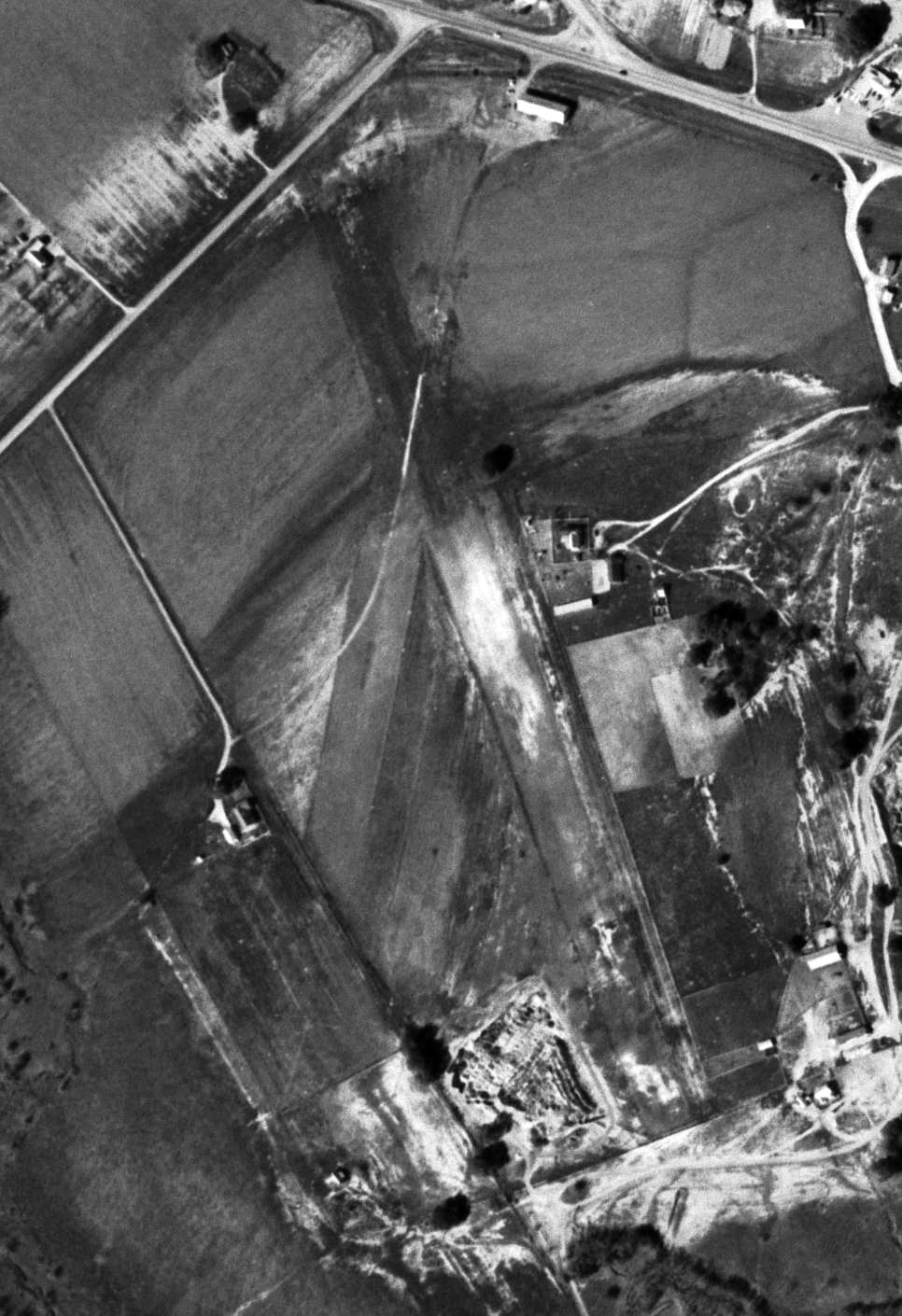
The only photo which has been located showing the Guenther Municipal Airport while open was a 2/1/57 USGS aerial view,
which depicted Guenther as having 2 unpaved runways, with 1 small hangar at the north end.
By the time of the 1964 San Antonio Sectional Chart, the primary runway at Guenther had been slightly lengthened, to 2,600'.
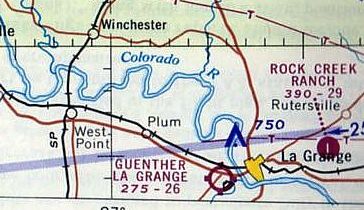
The 1966 Austin Sectional Chart (courtesy of John Price)
depicted Guenther La Grange as having a 2,600' unpaved runway.
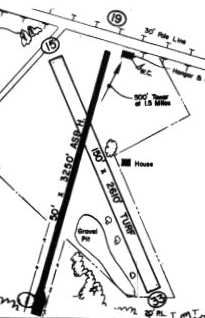
At some point between 1964-70, the primary runway at Guenther became a 3,350' asphalt Runway 1/19, as depicted in the 1970 TX Airport Directory.
A crosswind 2,610' grass Runway 15/33 continued to be operated as well.
A single hangar & office were depicted on the north side of the field, along the road.
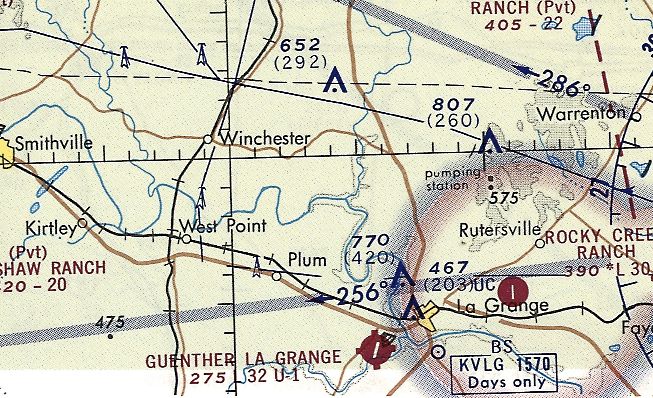
The last aeronautical chart depiction which has been located of Guenther La Grange Airport
was on the January 1972 San Antonio Sectional Chart (courtesy of Ron Plante).
It depicted Guenther La Grange Airport as having a 3,200' paved northeast/southwest runway.

The 1981 USGS topo map depicted Guenther Airport as having a single north/south runway.
In 1992 the new & larger Fayette Regional Air Center Airport was opened 2 miles west of La Grange,
and Guenther Municipal Airport was presumably closed at the same time.
“Guenther LaGrange” Airfield was depicted as “closed” on the May 1993 San Antonio Sectional Chart (courtesy of Ron Plante).
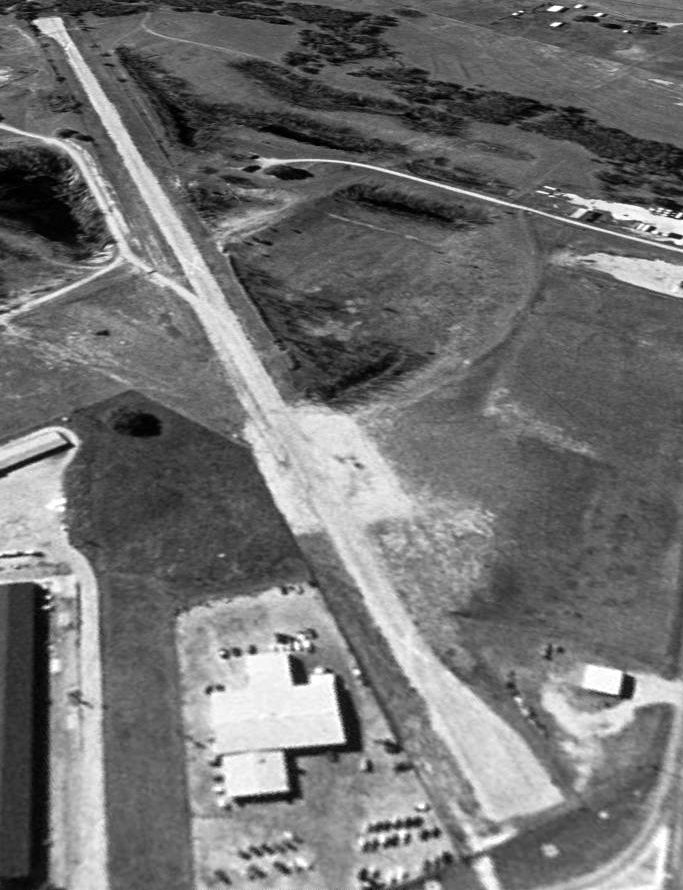
A 1/22/96 USGS aerial view looking southwest showed the paved runway of the former Guenther Municipal Airport remained completely intact.
Guenther Municipal Airport was still depicted as an abandoned airfield
on the October 2003 San Antonio Sectional Chart (courtesy of David Brooks).

A circa 2004-2010 aerial photo looking south showed the paved runway of the former Guenther Municipal Airport to remain completely intact,
with the northern end used for storage of trucks or trailers.
Note the oil well adjacent to the runway - probably the real reason for the airport's closure.
Bill Jacobs reported in 2011, “The old La Grange airfield... Its runway is still there although a used car dealer is located at the end of the runway.”
As of 2011, a street map labeled the runway as “Taylorcraft Airfield”, which may be erroneous.
The site of Guenther Municipal Airport is located south of the intersection of Route 71 & Route 609.
____________________________________________________
Tim's Airpark / Austin Executive Airpark (3R3), Austin, TX
30.42, -97.665 (Northeast of Austin, TX)
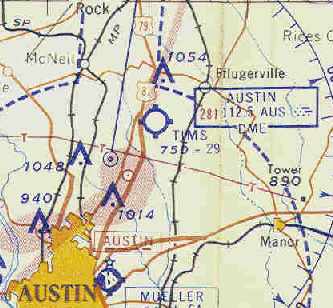
Tim's Airpark, as depicted on the April 1959 Austin Sectional Chart (courtesy of Chris Kennedy).
According to the book “Austin, Cleared For Takeoff” by William Ragsdale (courtesy of Rob Schmidt),
Theodore Timmerman purchased 250 acres of farmland in 1956.
Shortly thereafter. Jim Boutwell leased 20 acres to construct an airport.
Tims Airpark was not yet depicted on the March 1958 Austin Sectional Chart.
The earliest depiction of Tims which has been located was on the April 1959 Austin Sectional Chart (courtesy of Chris Kennedy).
It depicted the field as having a 2,900' unpaved runway.
Tim's Airpark apparently gained a paved runway within the next year,
as the 1962 AOPA Airport Directory described the field as having a single 2,800' asphalt Runway 17/35.
It listed the operator as Tim's Airpark Inc.
The 1963 TX Airport Directory (courtesy of Steve Cruse)
depicted Tim's Airpark as having an office & 2 hangars,
situated west of the runway along Dessau Road.
The manager was listed as Theodore Timmerman.
The orientation depicted of the runway, due north/south, may have been erroneous,
as every subsequent depiction of the runway shows it to be oriented north-northeast/south-southwest.
The earliest photo that has been located of Tim's Airpark was a 1964 aerial view.
It depicted the single runway, with several hangars & a dozen light planes on the northwest side.
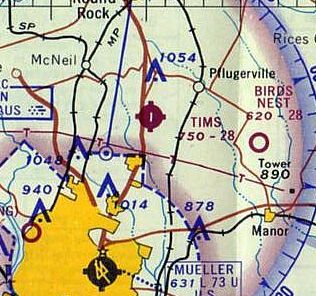
The 1966 Austin Sectional Chart (courtesy of John Price) depicted Tims Airpark as having a 2,800' paved runway.
A 1967 aerial view shows that another hangar had been added at some point between 1964-67.
By the time of the 1970 TX Airport Directory (courtesy of Ray Brindle),
the runway had been lengthened to 4,000' with a full-length parallel taxiway,
a larger ramp had been built along the west side of the runway,
and several new hangars had been built along the southwest side.
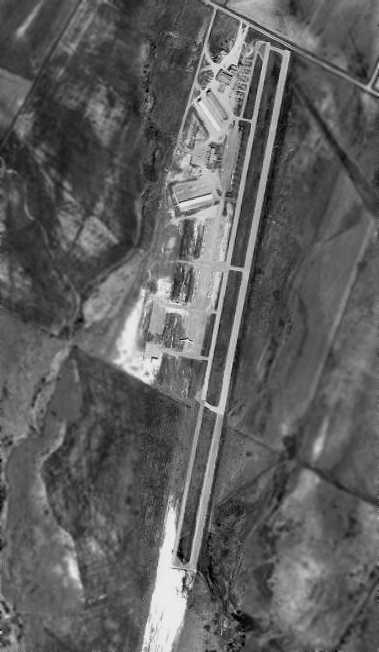
The earliest photo which is available of Tim's Airpark was a 1973 aerial view.
Yet another hangar had been added at some point between 1967-73.
A large number of aircraft were visible on the field, including a DC-3.
By the time of the 1985 TX Airport Directory (courtesy of Steve Cruse),
the airport had been renamed Austin Executive Airpark.
A 1985 aerial view showed 3 more hangars had been added at some point between 1973-85.
A large number of aircraft were visible on the field, including a DC-3.
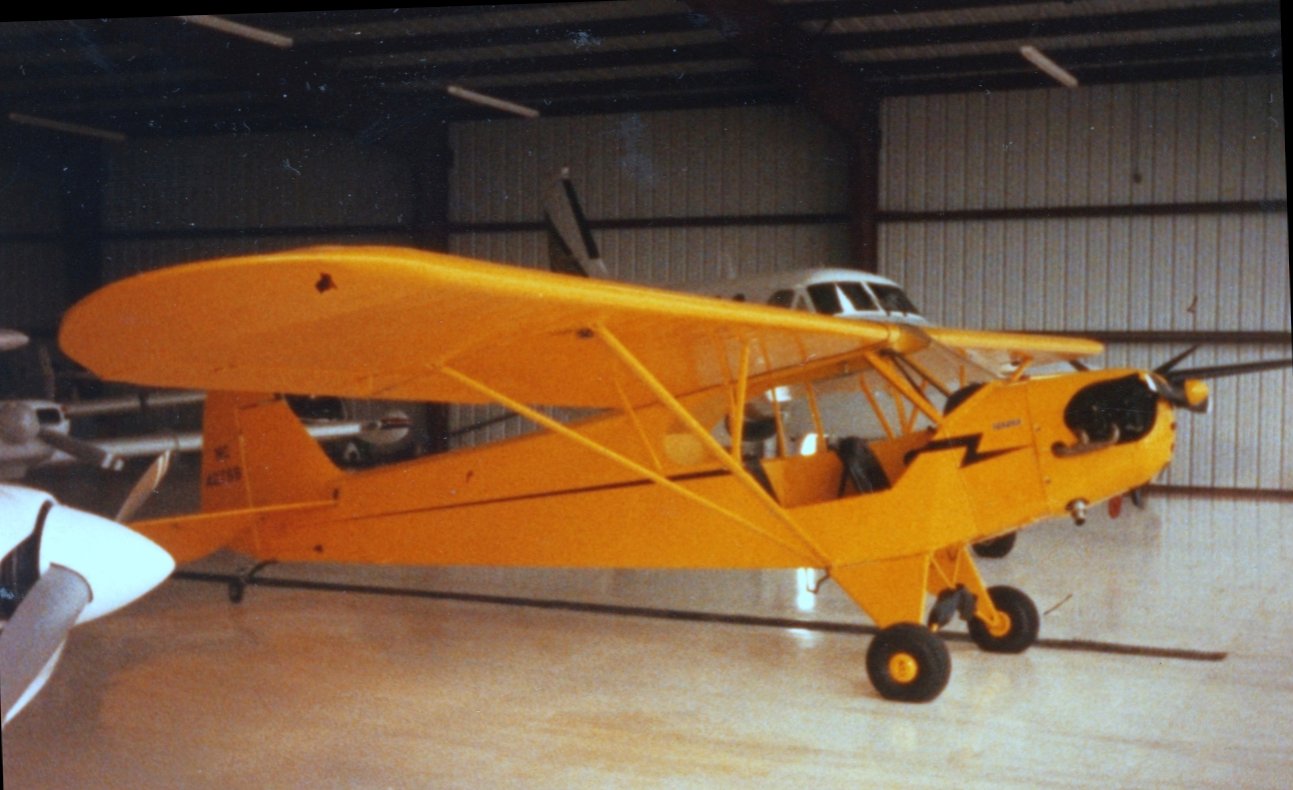
A late 1980s photo by William Snyder of a Piper J3 Cub inside an Austin Executive Airpark hangar.

A late 1980s photo by William Snyder of 2 Bell 206 JetRangers & a Bell 47 inside an Austin Executive Airpark hangar.

A late 1980s photo by William Snyder of a Stearman of the Red Baron aerobatic team at Austin Executive Airpark.
William recalled, “The Red Barron pizza biplanes would stop in when doing promotions around central TX.”
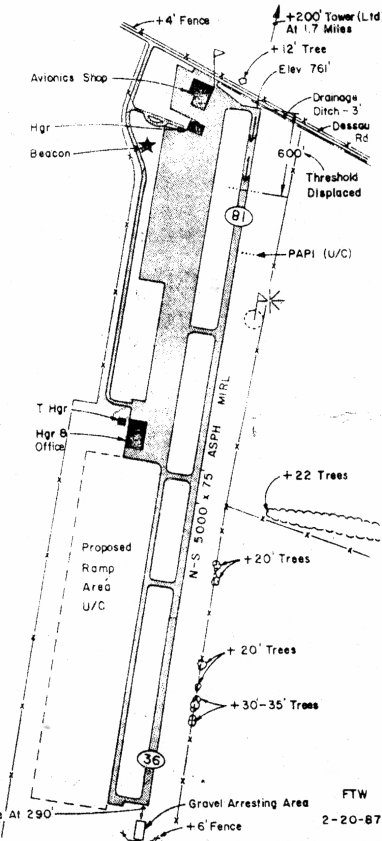
A 1987 Airport Directory (courtesy of William Snyder) depicted Austin Executive Airpark as having a 5,000' asphalt Runway 18/36.
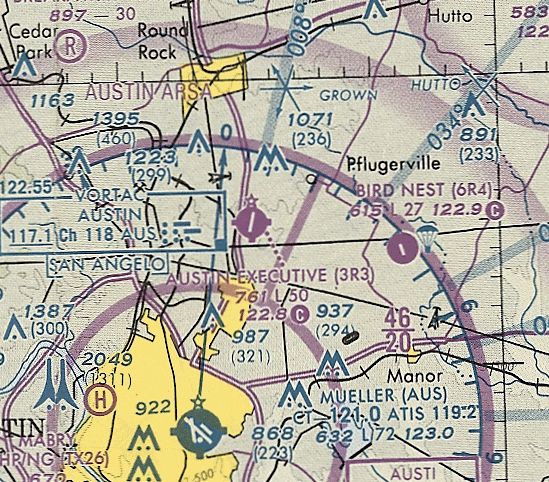
The last aeronautical chart depiction which has been located of Austin Executive Airport
was on the May 1993 Austin Sectional Chart (courtesy of Ron Plante).
It depicted Austin Executive Airport as having a 5,000' paved runway.
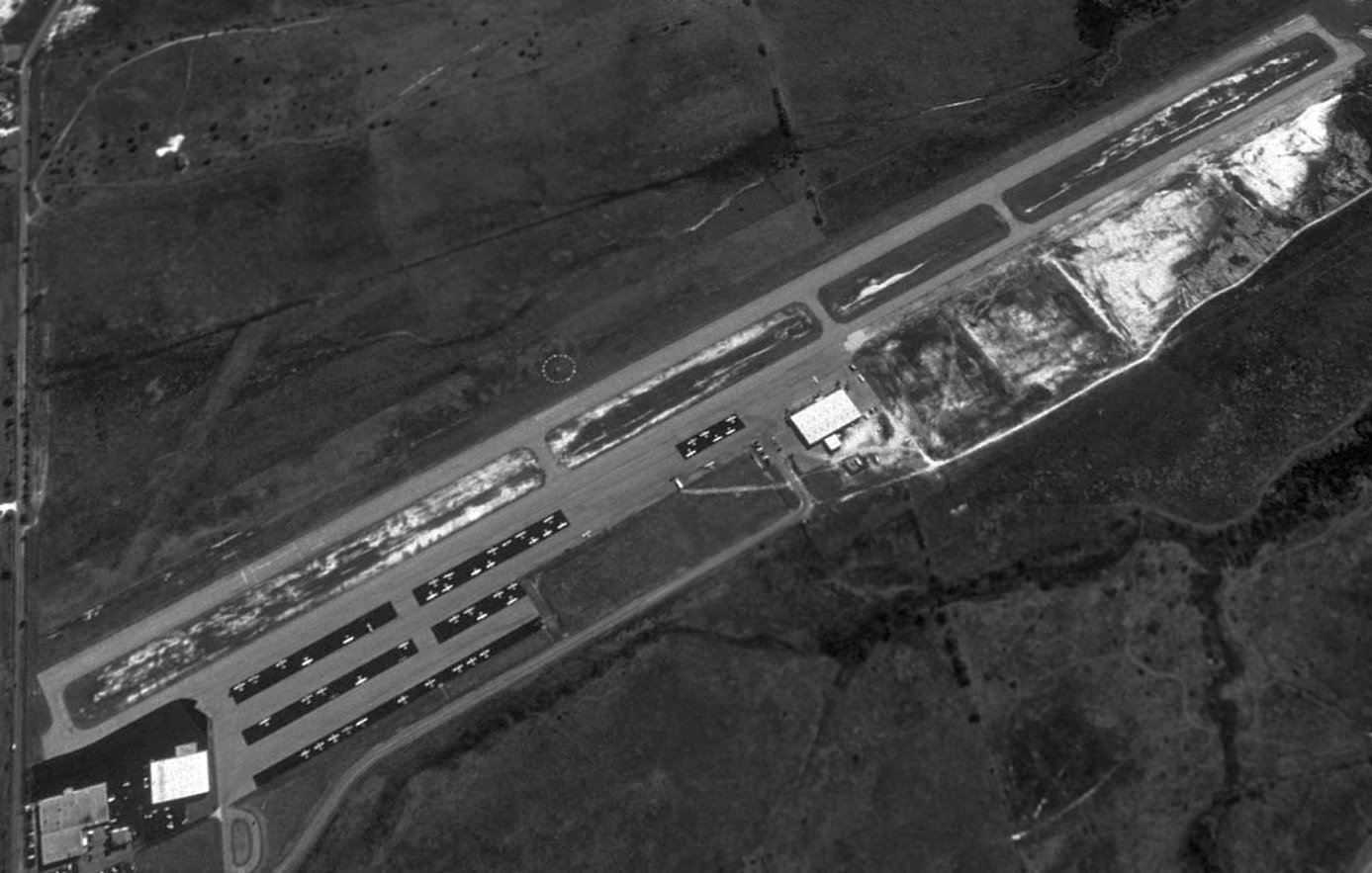
The last aerial photo which has been located showing Austin Executive Airport still in operation was a 2/1/95 USGS aerial view looking southeast.
The airport was evidently well-used right up to the end, as a total of over 50 light aircraft were visible on the field.

The last photos which have been located showing Austin Executive Airport still in operation was a pair of Fall 1996 photos by Artie Langston.
This was was of Patricia Griffin in front of a pretty red Ercoupe N666H.
Art Langston recalled, “Austin Executive... Many good times were had at that airfield, and I took a good deal of instruction from my friend Chuck in his Decathlon there.
One weird thing happened while I was based there. A guy parked a beige over brown Ercoupe close to mine, and we struck up a conversation.
He said he was a new owner, and invited me to lunch. He seemed like a nice fellow.
A few weeks later, his airplane was gone, along with my navigation light lenses.
Fast forward a few years later, and I'm watching TV in a hotel in New York City, and suddenly see the same Ercoupe on TV.
I'm watching, hoping it's a show about classic airplanes, but it turns out to be a true crime show!
The 'nice' guy who took me to lunch, and probably nicked my lenses, apparently murdered & dismembered his wife, and left her in a dumpster!
Still gives me chills!”

A Fall 1996 photo by Artie Langston of 3 Cessnas & a Piper Warrior at Austin Executive Airport.
Art Langston continued, “I may have been the very last to leave 3R3 before the runway was closed.
I had been based at Exec for some time with Ercoupe N2666H, and was saddened to find on landing that it was closing.
I kept careful note of the closing date, and when I departed, there were no other aircraft, not a soul around, and there was a sticker on my aircraft warning me to move it or else.”
Austin Executive Airport closed unexpectedly in 2000.
This came as a double blow to the general aviation community in Austin,
which in the preceding year had lost its only other airport supporting general aviation (Austin Mueller).
The last photo which has been located showing Austin Executive Airport still mostly intact was a circa 2000 aerial view, apparently after the field had been closed.
The runway was still intact, but most of the hangars had been removed,
and all of the large numbers of planes previously seen were gone.
A 2003 photo by Kent Dyer of the former runway at Austin Executive Airport, now reused for car racing by an firm called Tech.Ridge.
Nearby resident Kent Dyer reported in 2003 that the large buildings northeast of the airport are Dell Computer Corporation factories,
offices for NCS Pearson, and various tech vendors to Dell.
A 2003 photo by Kent Dyer of the former hangar at Austin Executive Airport,
now reused for non-aviation purposes by Lone Star Products.
Kent Dyer reported in 2005, “Car racing is no more at the old Austin Executive Airpark location.
'No Trespassing' signs are up all over the place,
and Wackenhut security patrols the location regularly (I believe they provide security for the Dell factories across the street).
I understand the racing kabosh is due to insurance liability issues -
and also it seems that the development of the area is really taking off.
Recently Dell Computer Corporation has begun parking empty trailers on the old tarmac,
and the old road that led into the airport from Howard Lane has been turned under by bulldozers,
and a City of Austin Metro Transit center is being built just west of where the airport used to be.”
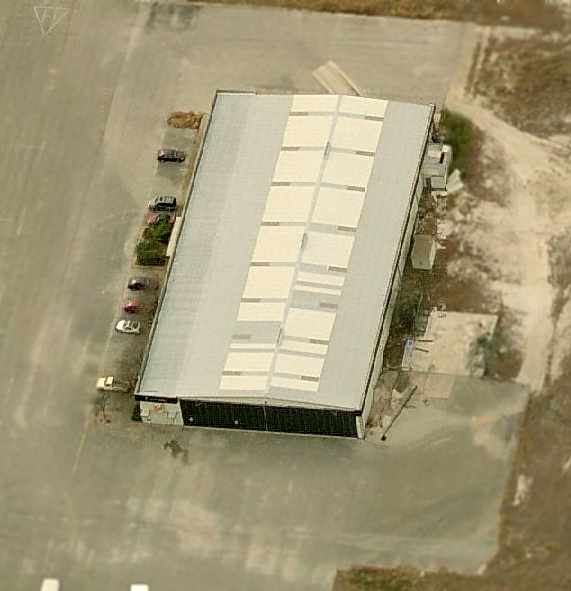
A circa 2005-2006 aerial view looking south at the former hangar
which remains standing on the west side of the former Austin Executive Airport.
Note the heliport symbol still perceptible at the top-left.
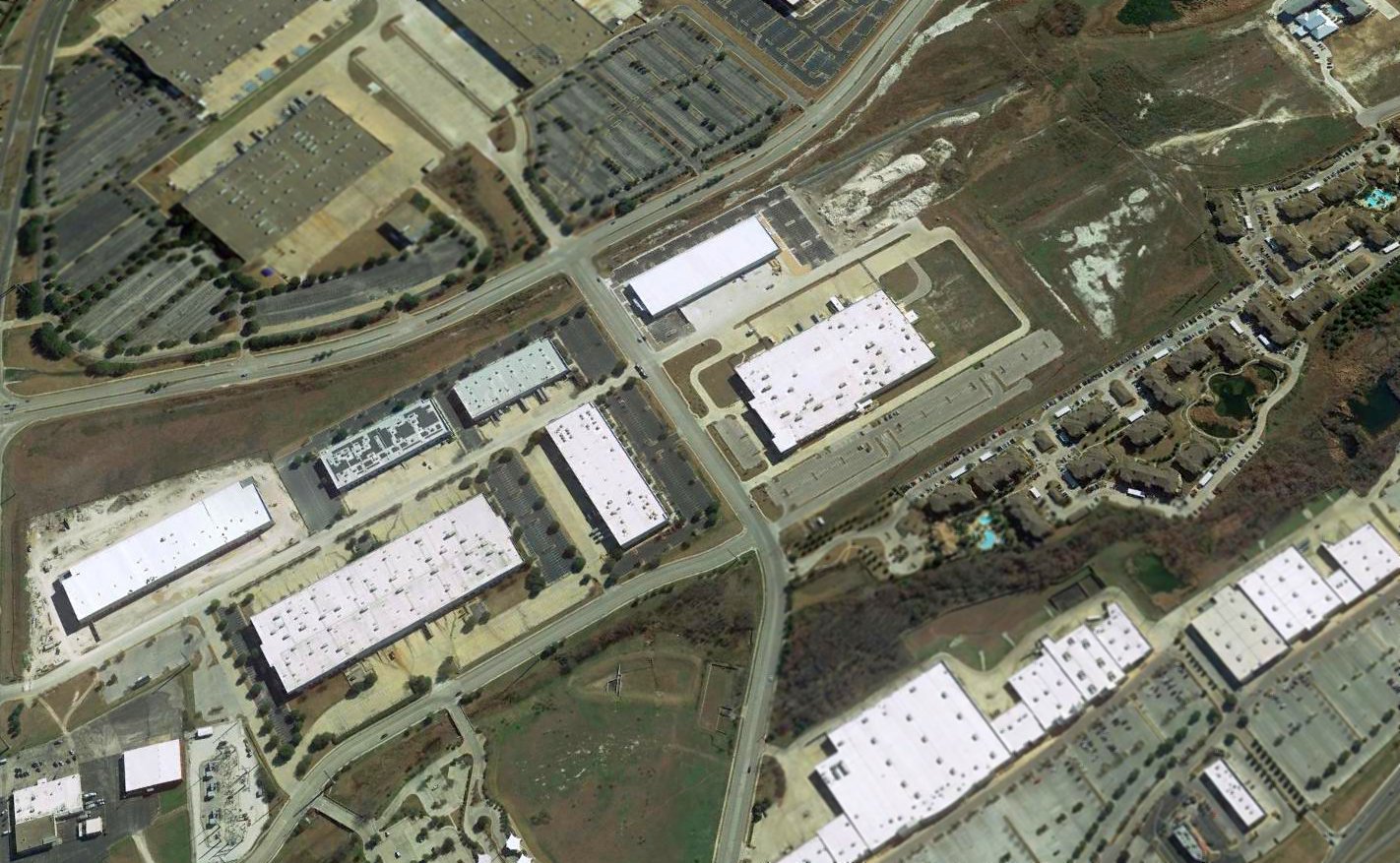
A 2017 aerial view looking southeast at the site of Austin Executive Airport showed quite a difference compared to earlier photos.
Large industrial buildings covered the northern end of the former airfield, but the original airport buildings remained intact at the northern end.
A slight trace of the runway pavement was still perceptible on the south end (top-right of picture).
____________________________________________________
Since this site was first put on the web in 1999, its popularity has grown tremendously.
If the total quantity of material on this site is to continue to grow,
it will require ever-increasing funding to pay its expenses.
Therefore, I request financial contributions from site visitors,
to help defray the increasing costs of the site
and ensure that it continues to be available & to grow.
What would you pay for a good aviation magazine, or a good aviation book?
Please consider a donation of an equivalent amount, at the least.
This site is not supported by commercial advertising –
it is purely supported by donations.
If you enjoy the site, and would like to make a financial contribution,
you
may use a credit card via
![]() :
:
Please consider checking the box to make a monthly donatation.
For a mailing address to send a check, please contact me at: paulandterryfreeman@gmail.com
If you enjoy this web site, please support it with a financial contribution.
please contact me at: paulandterryfreeman@gmail.com
If you enjoy this web site, please support it with a financial contribution.
____________________________________________________
This site covers airfields in all 50 states.